| 1 |
Amaranthus sessilis (L.) R. Br. |
Amaranthaceae |
Erect glabrous herbs, profusely branched, branches ridged distinctly; spines divaricate, sharp. Leaves of various shape ovate elliptical, lanceolate, lanceolate-oblong , leaf base attenuate, apex obtuse or subacute; petiolate, petiole 1cm to 4 cm long. Flowers in terminal panicles, spikes or in axillary, sessile clusters. Bracteate ,bract minute, ovate-lanceolate in shape. Male flowers: 1-2 mm across; tepals 5, calycine, unequal, ovate-lanceolate; stamens 5; anthers sagittate. Female flowers: 1-2 mm across; tepals 5, oblong, acute at apex; ovary 1-celled; ovules solitary; stigmas 2-3. Seeds minute, discoid
|
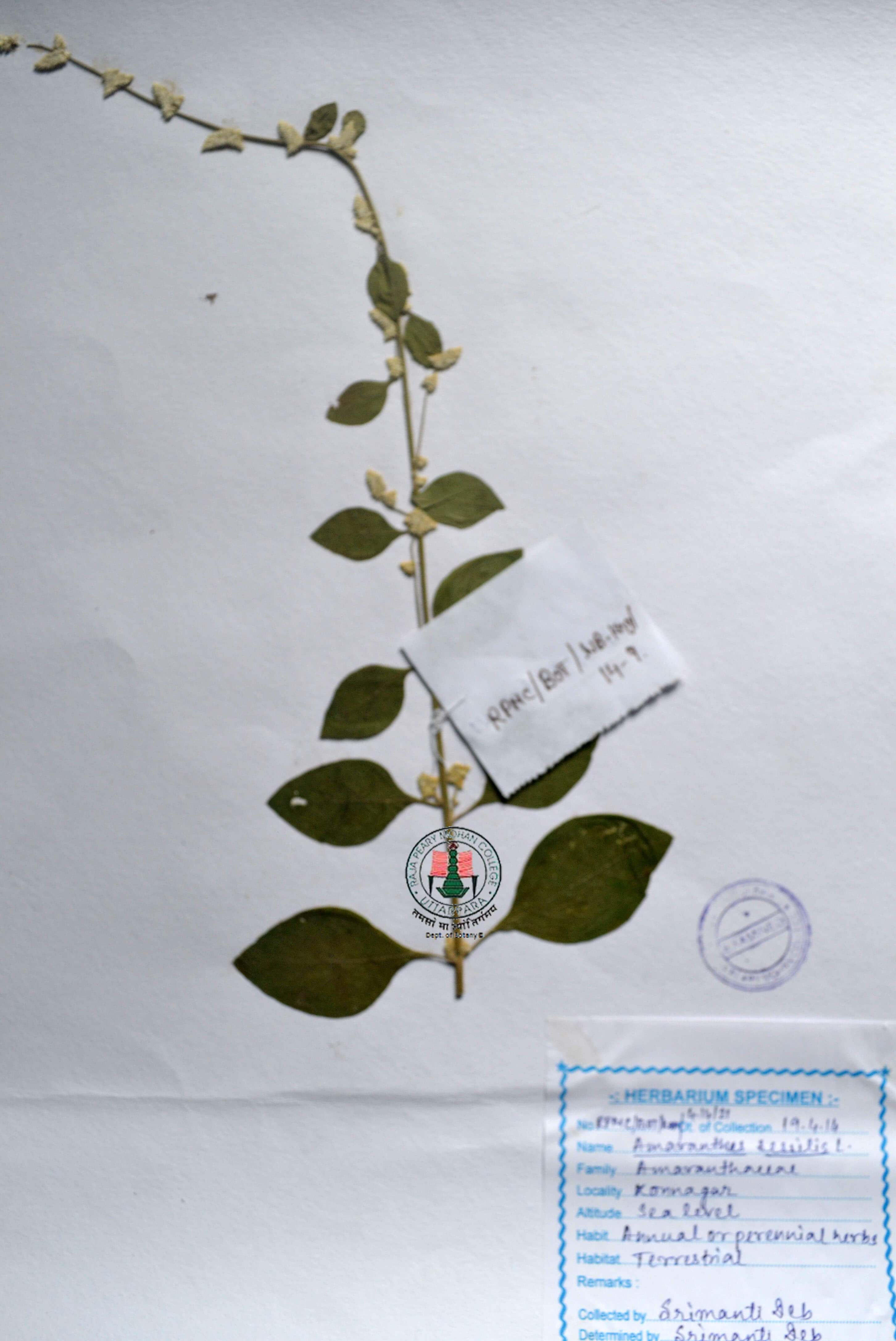
|
| 2 |
Peristrophe bicalyculata Nees |
Acanthaceae |
A laxy panicled, spreading, hispid, 4-6 angled; leaves ovate, acuminate, simple, flowers in trichotomous cymes; flowers bracteates and bracteolate, corolla pink, elliptic, obtuse, bi-labiate, ovary hairy at tips; fruits capsules
|
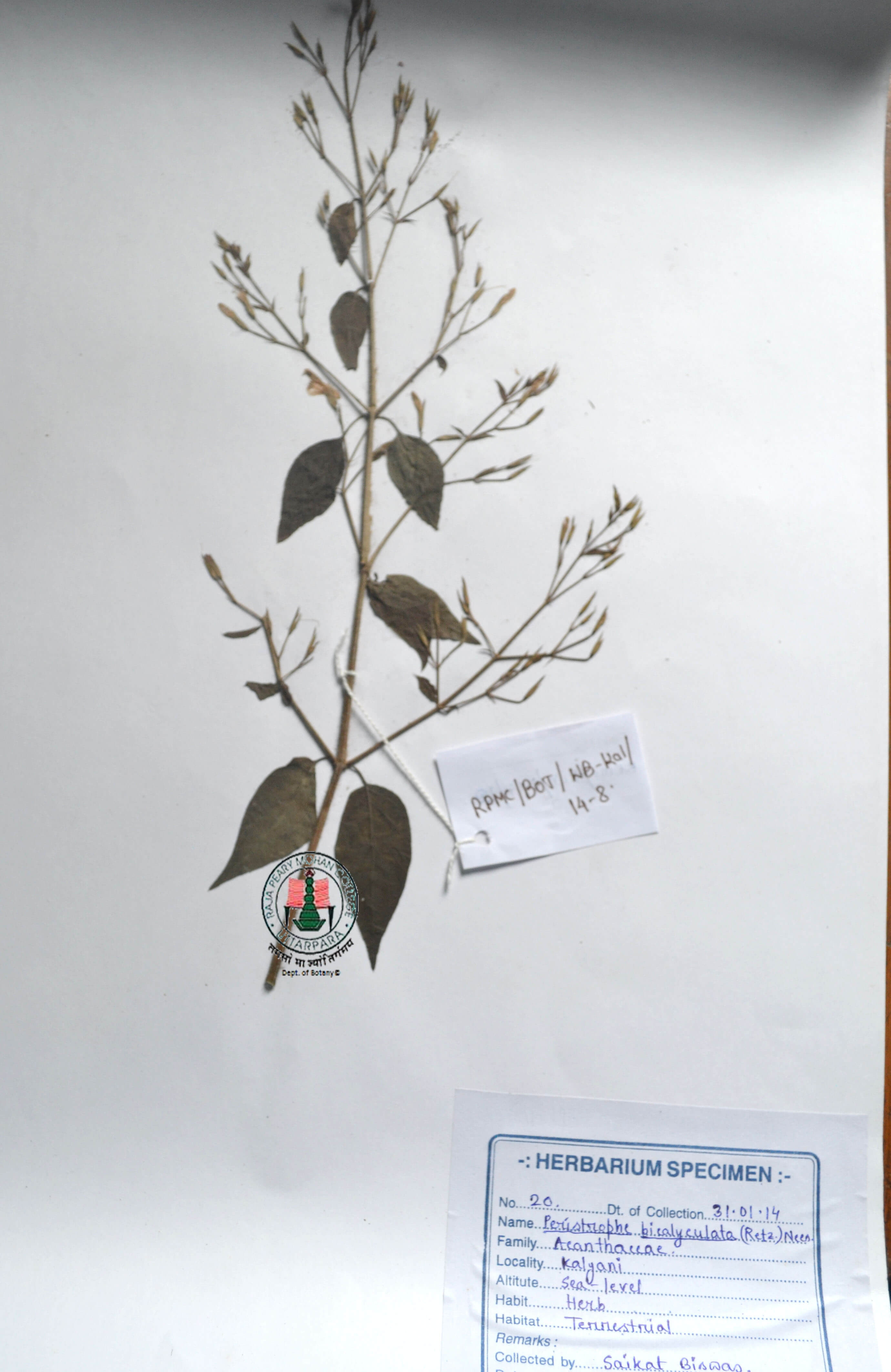
|
| 3 |
Amaranthus viridis L. |
Amaranthaceae |
Annual herb up to 1 m tall; stem erect, branched, herbaceous, and green; leaves simple, alternate, petiolate, entire, lanceolate, dark green; flowers are small, numerous, greenish, arranged in spike; fruit capsule
|
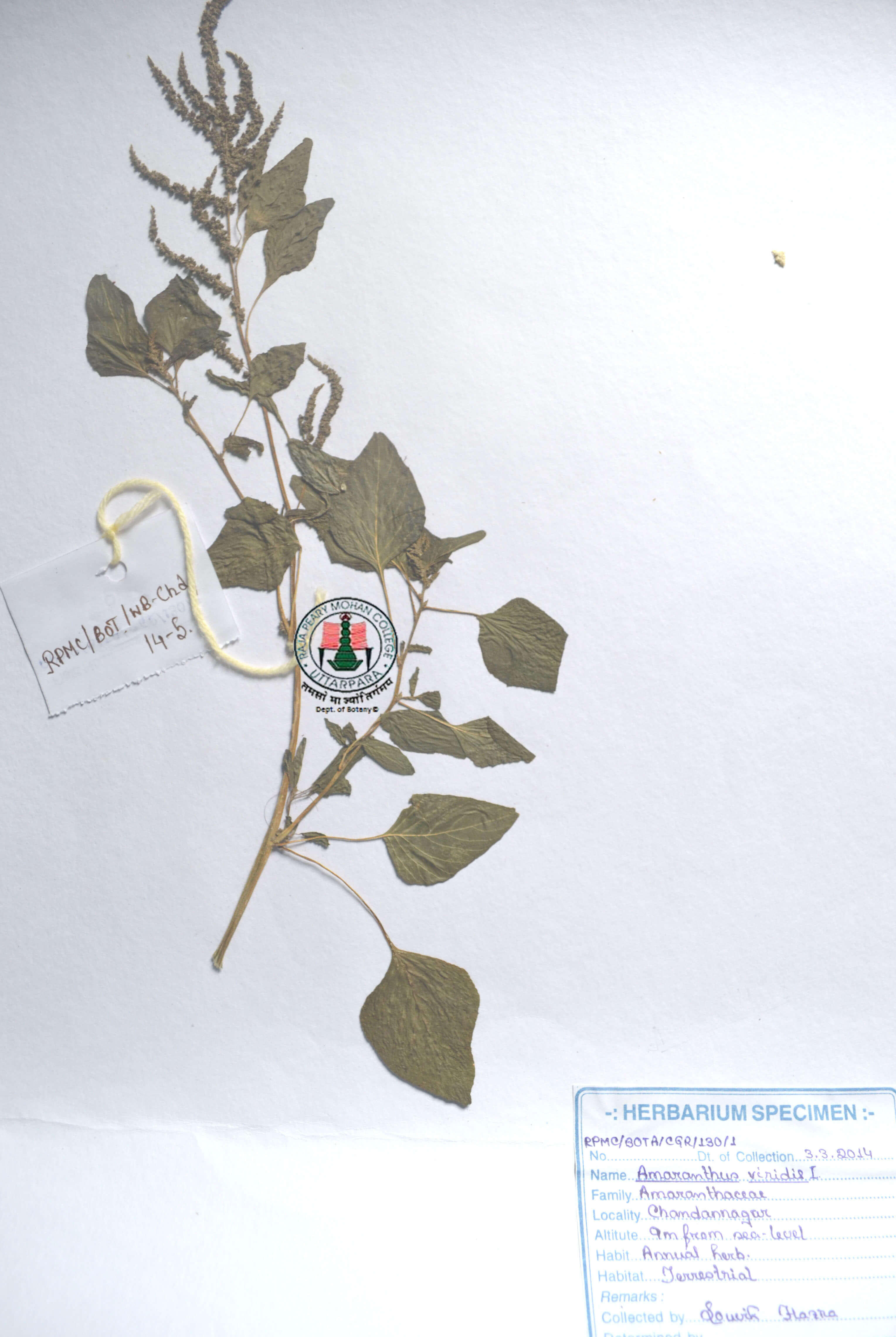
|
| 4 |
Galium sp |
Rubiaceae |
Semi-erect, 4-angled stems; leaves ovate-lanceolate, simple, interpetiolar stipulate; the stem. The whole plant is covered in minute hooked hairs, and can cling to skin, fur and clothing. The flowers are beautiful, pink, 4-petalled tubes
|
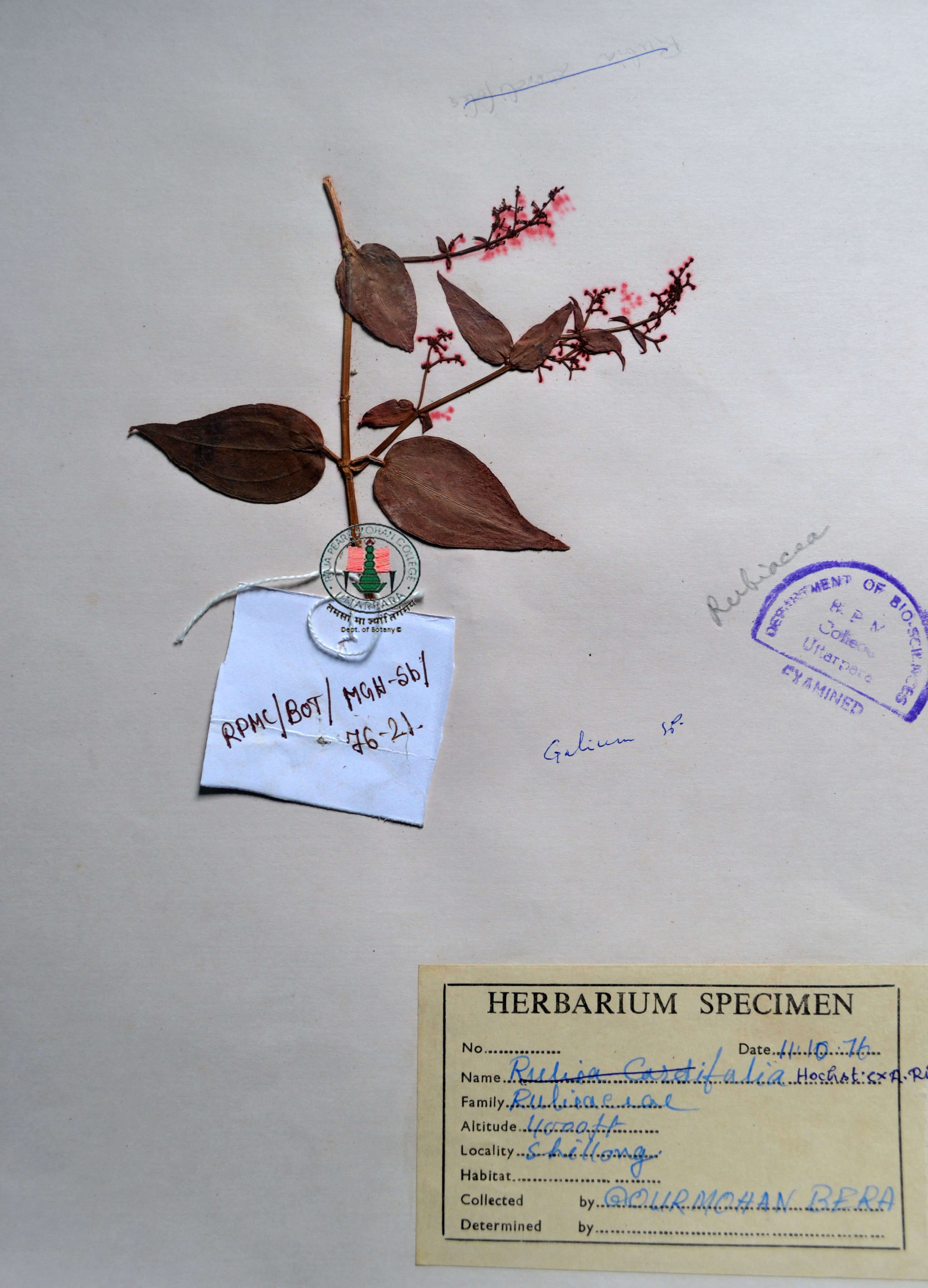
|
| 5 |
Callicarpa floribanda/C. macrophylla Vahl. |
Lamiaceae |
Erect shrub or small-tree evergreen; leaves are simple, opposite, and 5–25 cm long. The flowers are in clusters, white to pinkish; fruit berry, 2–5 mm diameter and pink to red-purple with a highly distinctive metallic lustre, are very conspicuous in clusters on the bare branches after the leaves fall.
|
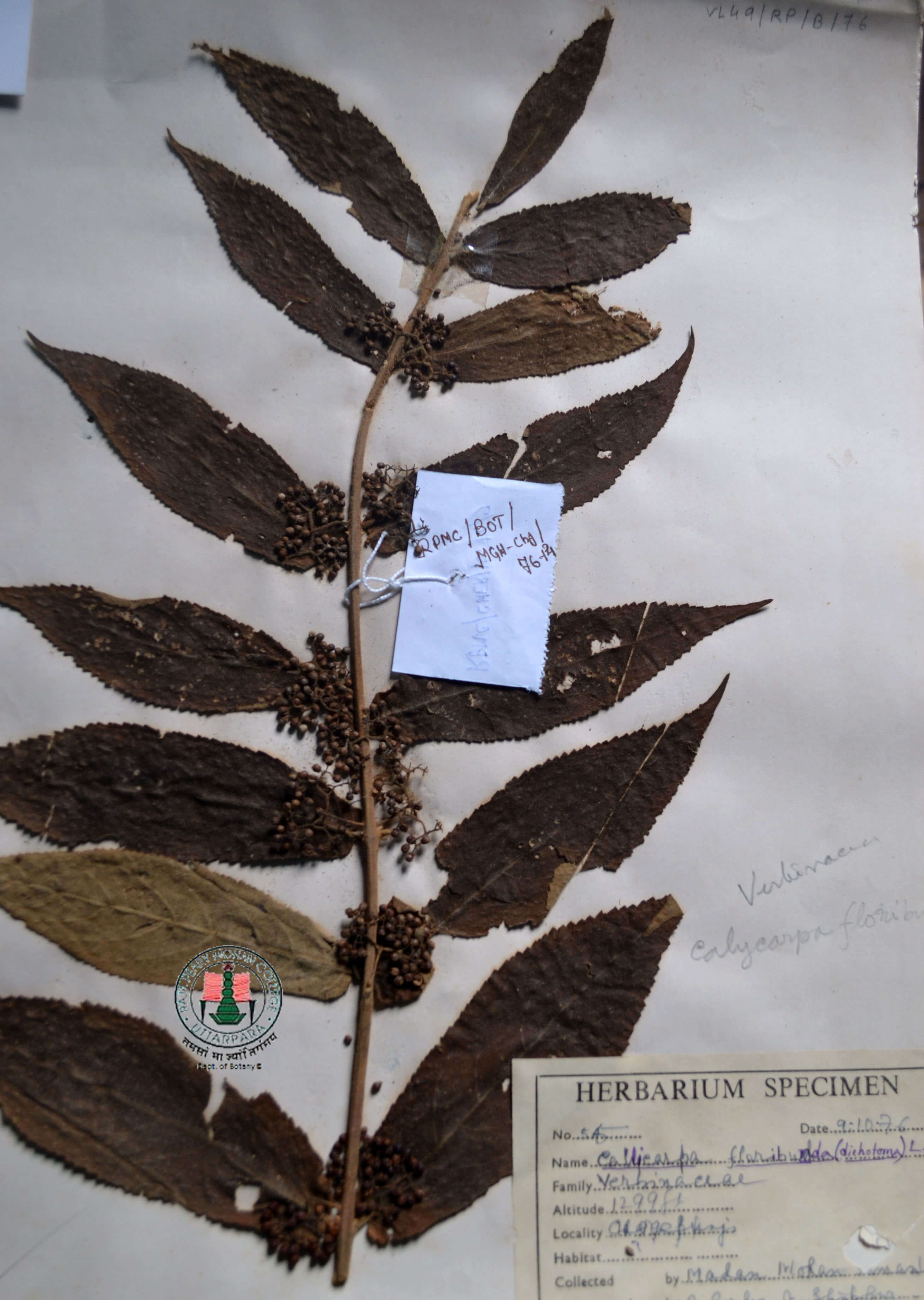
|
| 6 |
Alternanthera sessilis R.Br. ex DC. |
Amaranthaceae |
Perennial much branched prostrate herb; stems prostrate, rarely ascending; leaves simple, opposite, somewhat fleshy, obovate to broadly elliptic, occasionally linear-lanceolate, glabrous to sparsely villous, shortly petiolate; flowers in sessile spikes, bract and bracteolate, shiny white, glabrous; flowers are situated over the stem with shape as round; sepals equal, outer ones mono-nerved or indistinctly 3-nerved toward base; stamens 5, sterile; fruits obcordate utricles.
|
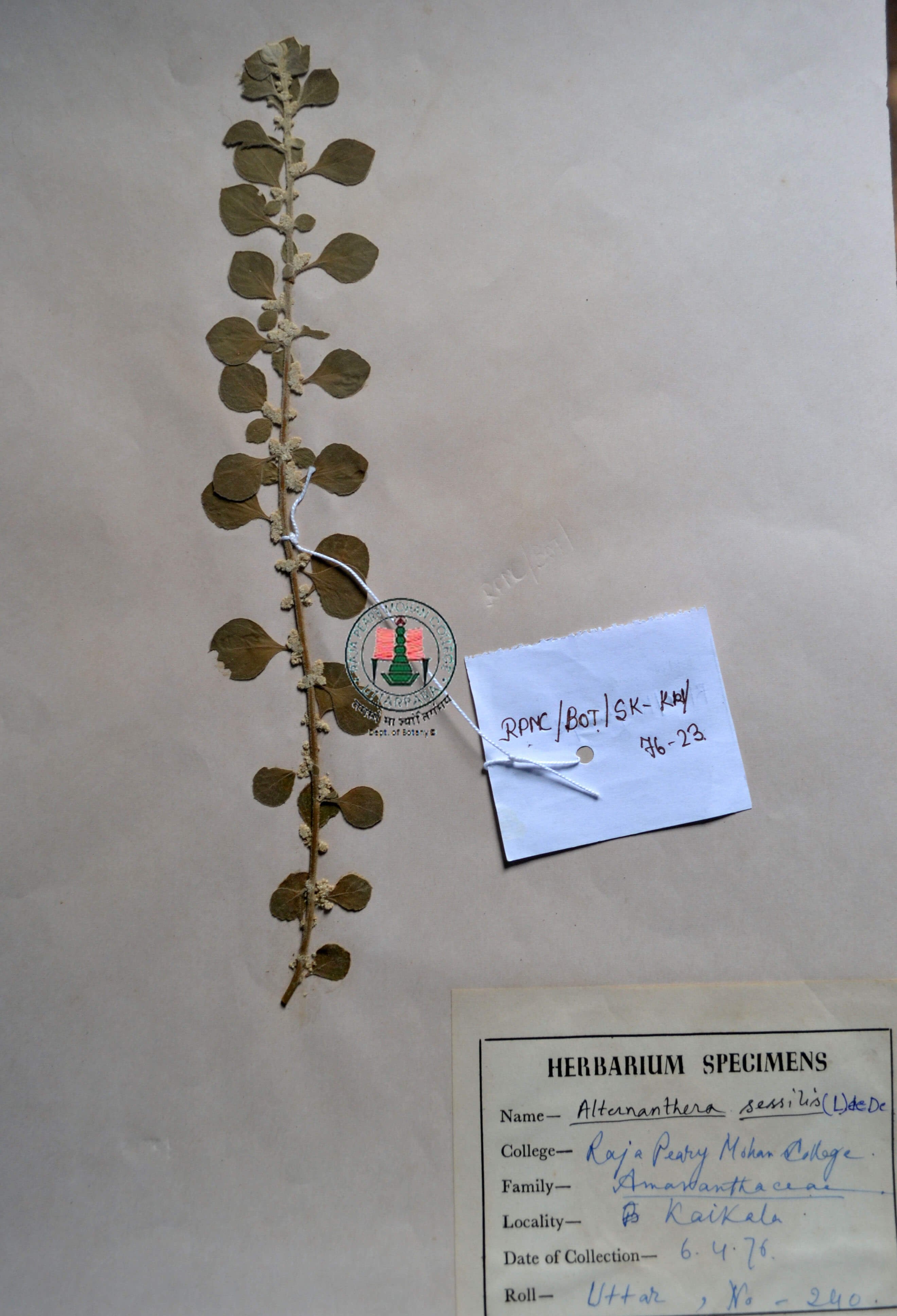
|
| 7 |
Liucula sp. |
not Confirmed yet |
not Confirmed yet
|
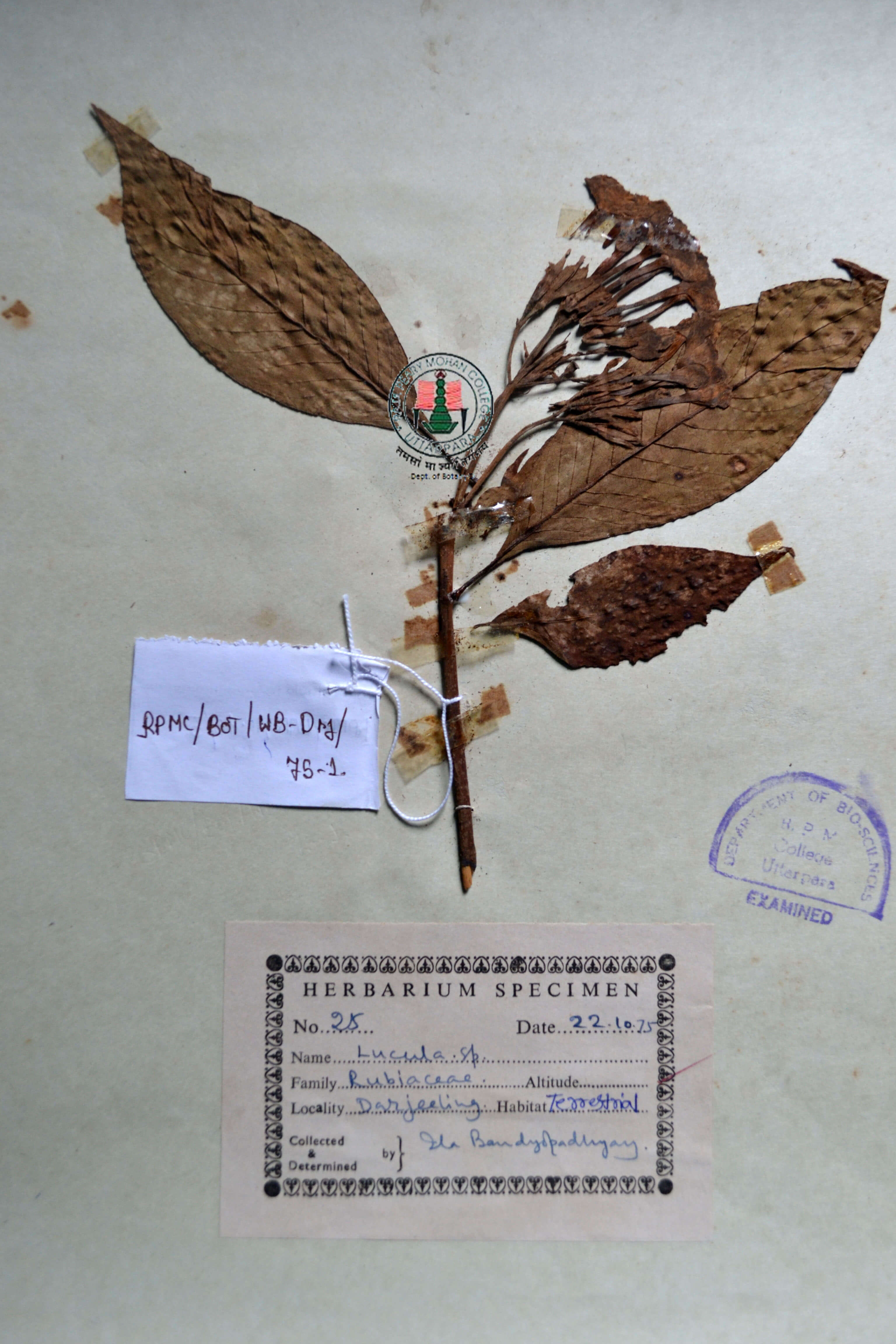
|
| 8 |
Galium mollugo (Mill.) Tzvelev |
Rubiaceae |
1–2 and half inch long and unbranched, except near the inflorescence. The lower stem is often decumbent along the ground, while the upper stem and inflorescence are more or less erect. Stem is glabrous, 4-angled, and often furrowed; it becomes slightly swollen where the whorls of leaves occur. Each whorl has 6-8 leaves; these whorls of leaves become rather widely spaced as the central stem elongates. It is oblong or oblanceolate, glabrous, and smooth along its margin; sometimes this margin is slightly ciliate. Stem terminates in a panicle of cymes up to 1 inch long. This panicle is longer than it is broad and contains a multitude of small white flowers. There is often a pair of small leaves (or leafy bracts) at the base of each cyme along the central flowering stalk. Each flower is about 1/6 inch (4 mm.) across. It has a white corolla with 4 lobes (rarely 3) and a pair of ovoid carpels at its base that are green, hairless, and joined together. The throat of the corolla is quite narrow, from which there protrudes a pair of styles. Each lobe of the corolla becomes pointed at its tip.
|
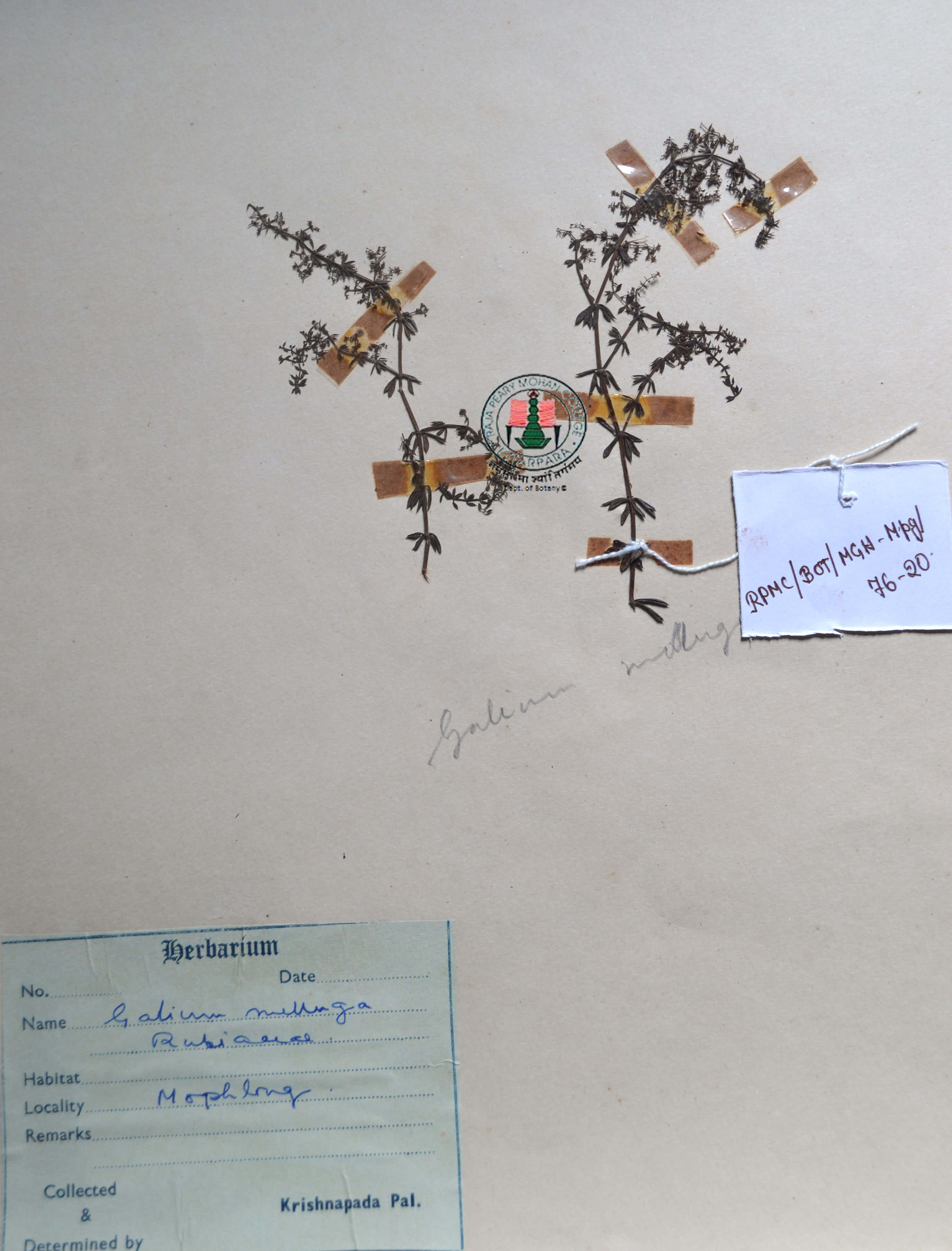
|
| 9 |
Cestrum aurantiacum Lindl. |
Solanaceae |
Large, evergreen flowering shrub, but it can also be a climbing vine or small tree; alternate leaves are light green and ovate with entire leaf margin (13 cm long, 7 cm wide). Leaf apex is acute or has a distinct drip tip; flowers golden yellow flowers are tubular with 5 - 6 small, round lobes; arranged in clusters at branch tips (terminal clusters) and in leaf axils (axillary clusters). Flowers produce a citrus-like fragrance at night. This species blooms constantly throughout most of the year; fruits are small, round, white berries.
|
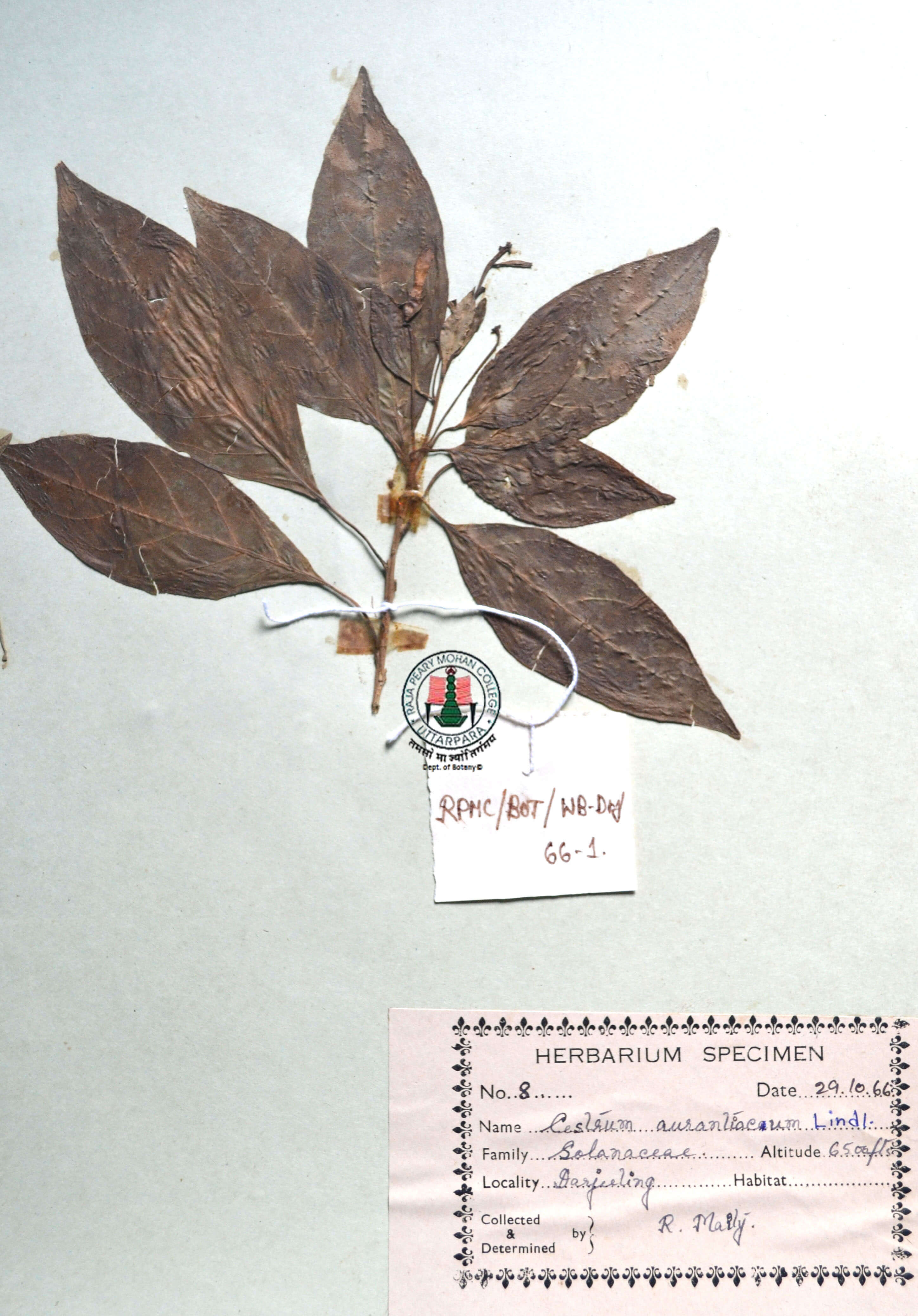
|
| 10 |
Solanum seaforthianum Andrews |
Solanaceae |
Woody vines; Clusters of four to seven leaves and can climb to a height of 20 ft given enough room. Leaves are mostly pinnately cut into almost leaflets. Leaves are ovate in outline, 4-10 cm long, 3-6 cm wide, deeply lobed, both surfaces green and smooth except for hairs on margins and veins on lower surface. Leaf-stalk is 2-4 cm long. The plant blooms in the mid to late summer with clusters of star-shaped purple inflorescence followed by scarlet marble-sized berries. Inflorescences are 10-50-flowered, carried on 1-6 cm long stalks. The rachis is up to 10 cm long, flower-stalks 1-1.5 cm long. Sepal tube is 1.5-2.5 mm long, sepals about 1 mm long. Flowers are deeply incised, 2-3 cm across, mauve-blue
|
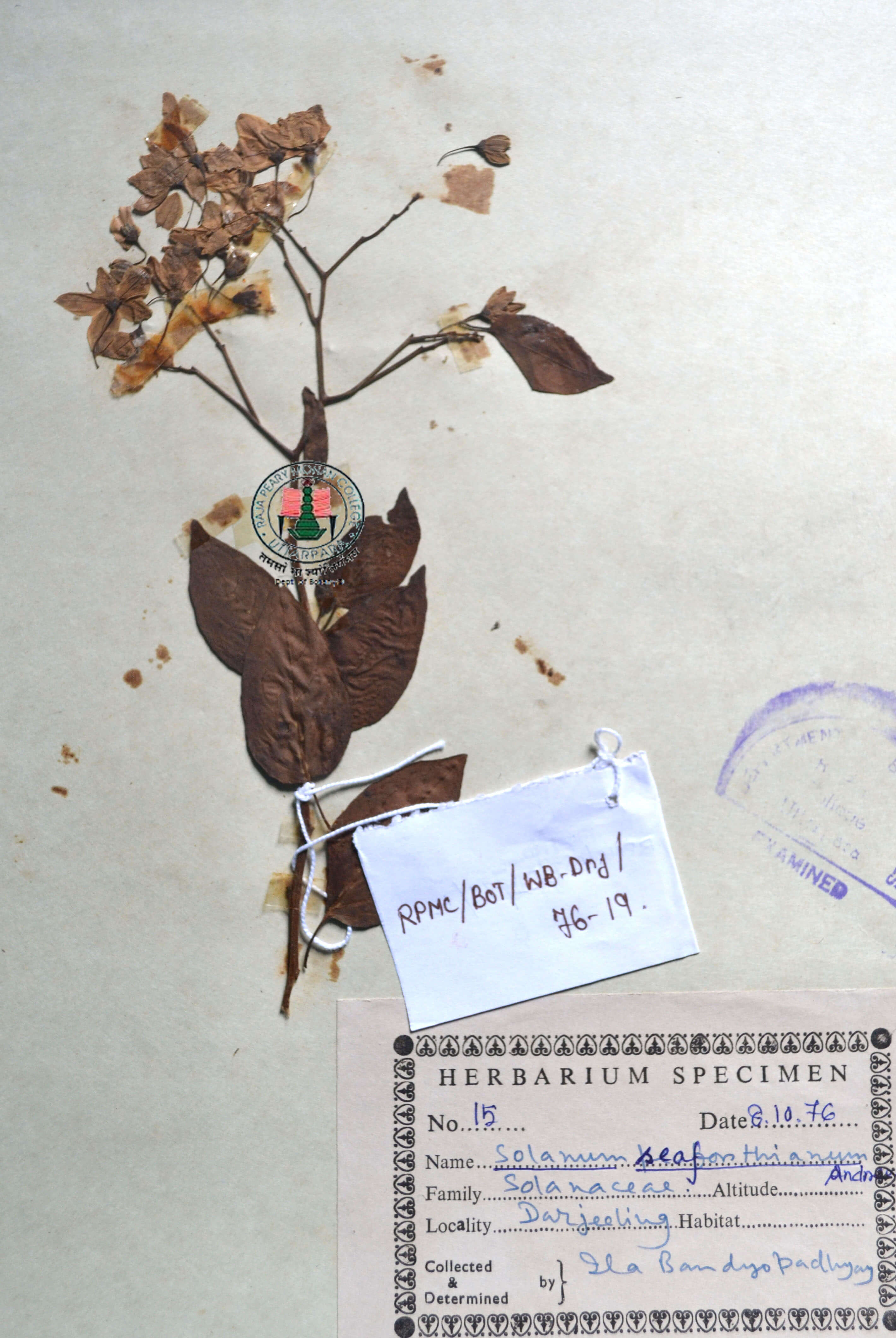
|
| 11 |
Solanum sisymbriifolium Lam. |
Solanaceae |
Annual rhizomatous herb, stem branches are viscoid, ovate to lanceolate leaves with glandular stellet hairs, pinnately divided into 4-6 lobes, stem, fruits and leaves contains solasodine, unbranched raceme inflorescence composed of 1-10 perfect or staminate flower; fruits red succulent globular berries with pale yellow seeds.
|
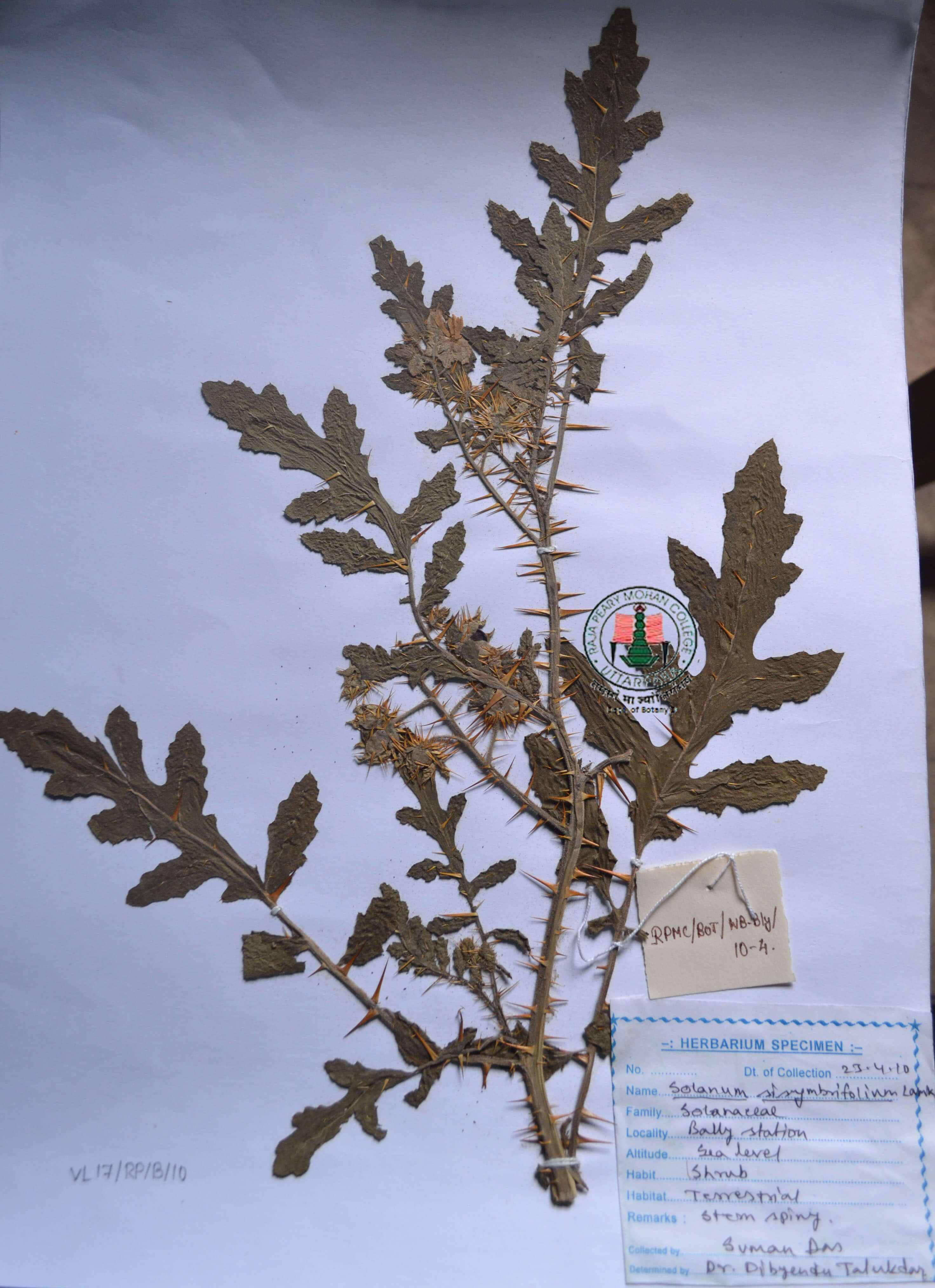
|
| 12 |
Cestrum diurnum L. |
Solanaceae |
An erect evergreen perennial shrub, branches with white lenticels, young parts glandular; leaves dark green above, pale below, ovate-lanceolate, obtuse, glabrous; flowers white, scented in axillary cymes; inflorescence pedunculate bearing clusters of flowers, subtended by leaf-like bracts; calyx small, 5-lobed, ciliate; corolla tubular, lobes 5, reflexed; stamens 5, included; ovary 2-celled, style slender, stigma capitates; fruits berry, globose
|
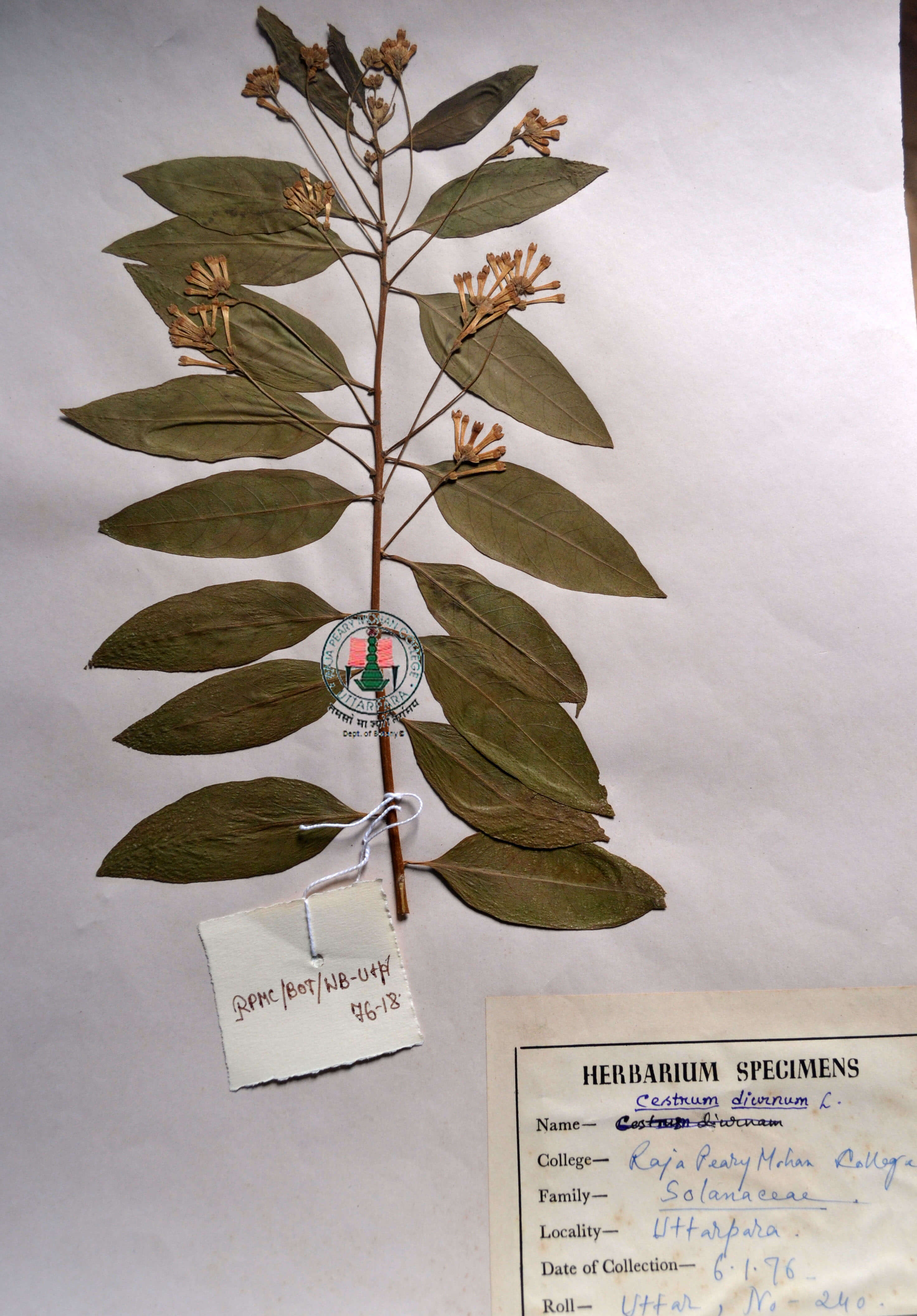
|
| 13 |
Cardanthera triflora Buch.-Ham. Ex Nees |
Acanthaceae |
Viscid aromatic herbs; stem erect or ascending, rooting at nodes, Leaves opposite, dimorphic, submerged leaves, pinnately or bipinnately dissected,serrate-dentate, densely glandular hairy above. Flowers axillary. Corolla pale blue with a purple palate, 1.3 cm long, bilabiate, lower lip pubescent, shortly 3-lobed at apex, upper lip shortly 2-lobed. Stamens 4, didynamous; filaments hairy at base; Style filiform, pubescent; stigma 2-fid; Capsule; seeds many.
|
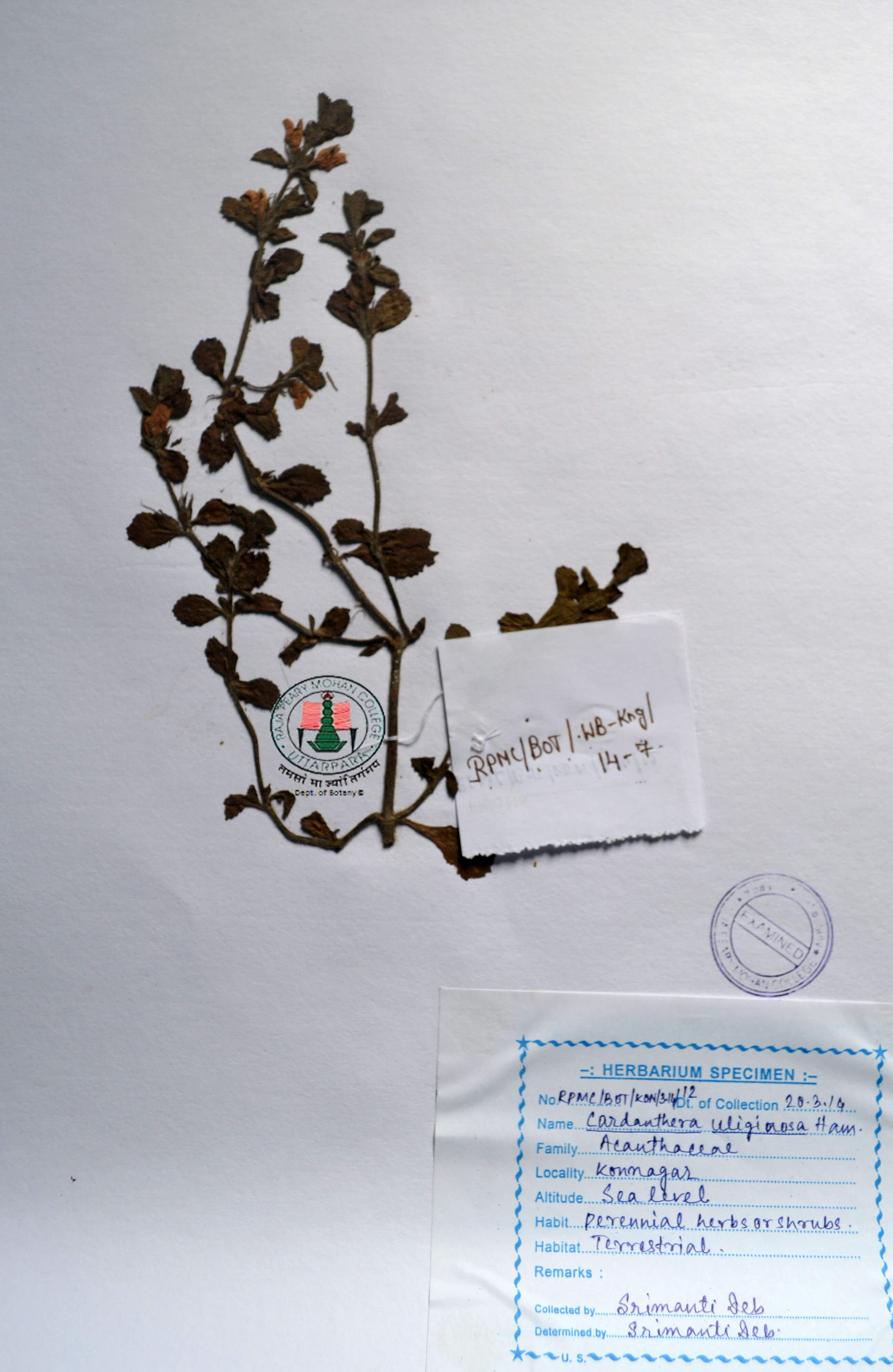
|
| 14 |
Not Identified |
Acanthaceae |
|
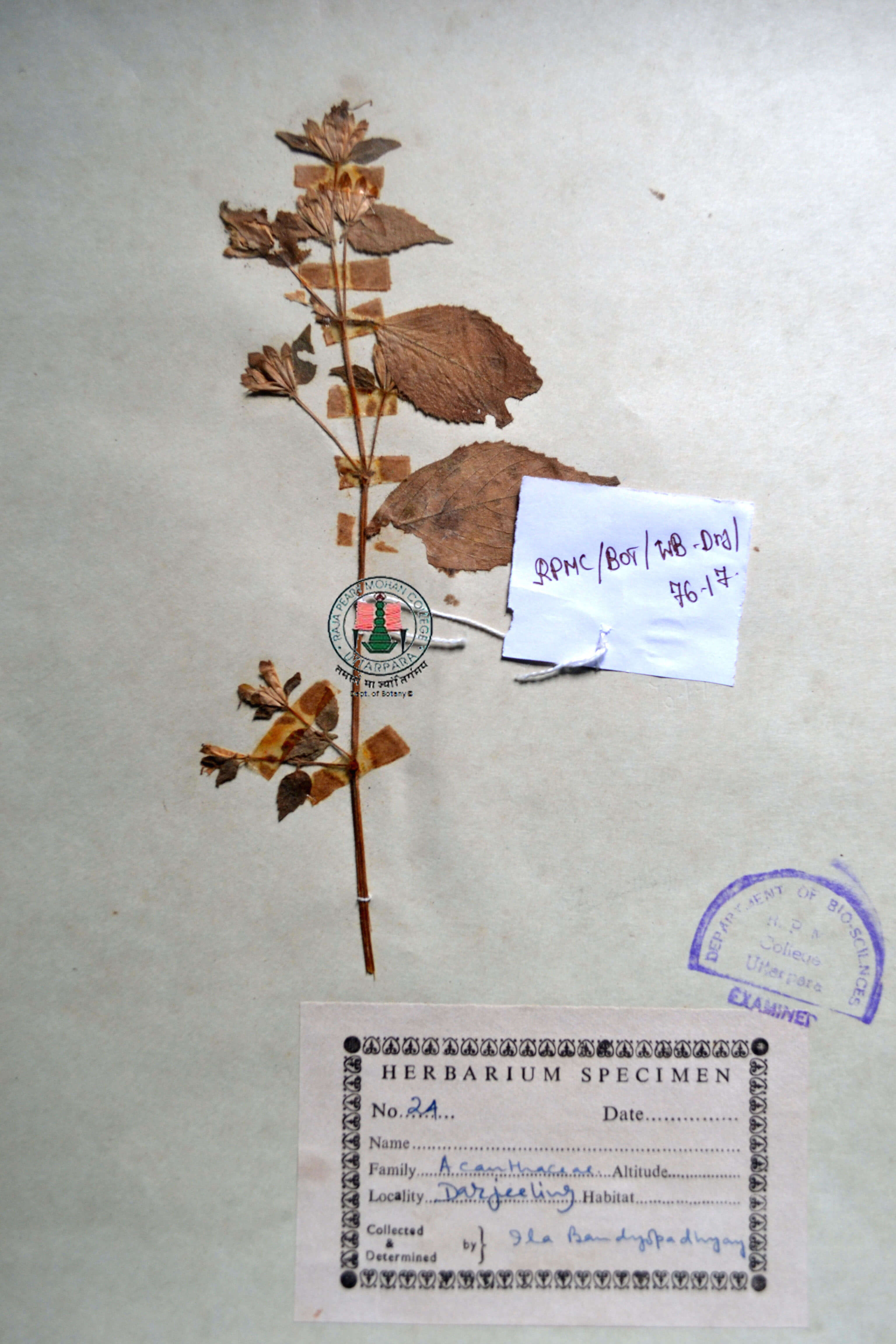
|
| 15 |
Barleria cristata L. |
Acanthaceae |
Erect shrub with glabrous, swollen nodes, young stem which is grey, slightly four angled, usually with 3-4 divaricate spines at axil of leaf; leaves deep green at upper but pale green at lower surface; leaves oval-ellipsoid shaped; variable in size, simple, acuminate at apex, entire at margin, acute at apex, unicostate reticulate venation, glabrous above, glabrous or pubescent/ spiny beneath; flowers tubular yellow–orange, with protruding stamens, sessile, often solitary axillary, becoming spicate above; bracts foliaceous, oblong or lanceolate, bristle-tipped; bracteoles 1.3 cm long, narrowly linear, subulate (almost spinous), bristle-tipped; stamens 2 fertile + 2 staminodes; fertile filament exerted beyond the corona tube, those of the staminode very short. Ovary superior of two fused carpels; fruits capsule-ellipsoid
|
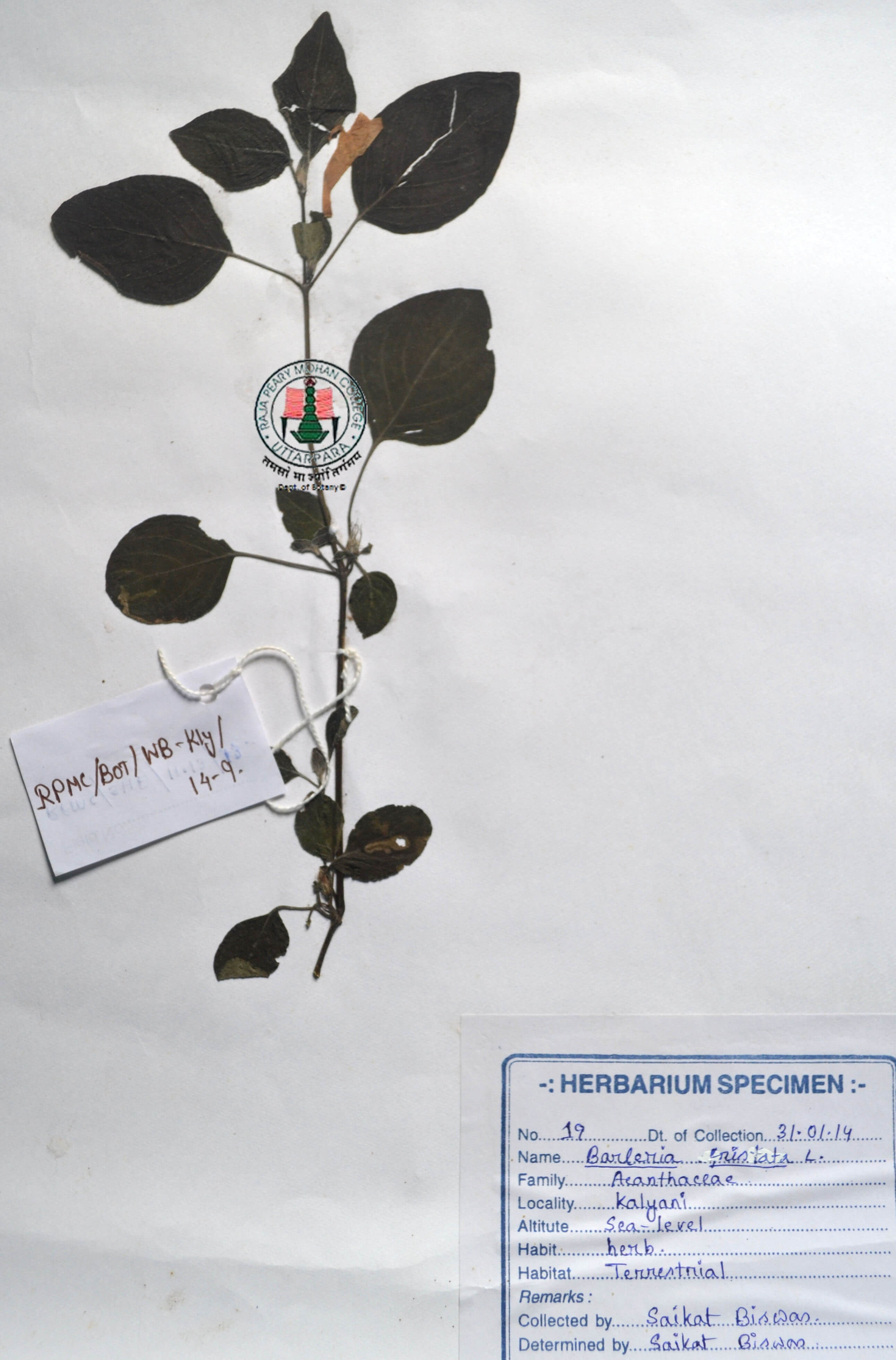
|
| 16 |
Polygonum spp |
Polygonaceae |
Erect plant; leaves simple, alternate, petiolate, acute at apex, entire at margin, semi-sagittate in shape; stipulate; stipule ochreate; placentation basal; fruits capsule
|
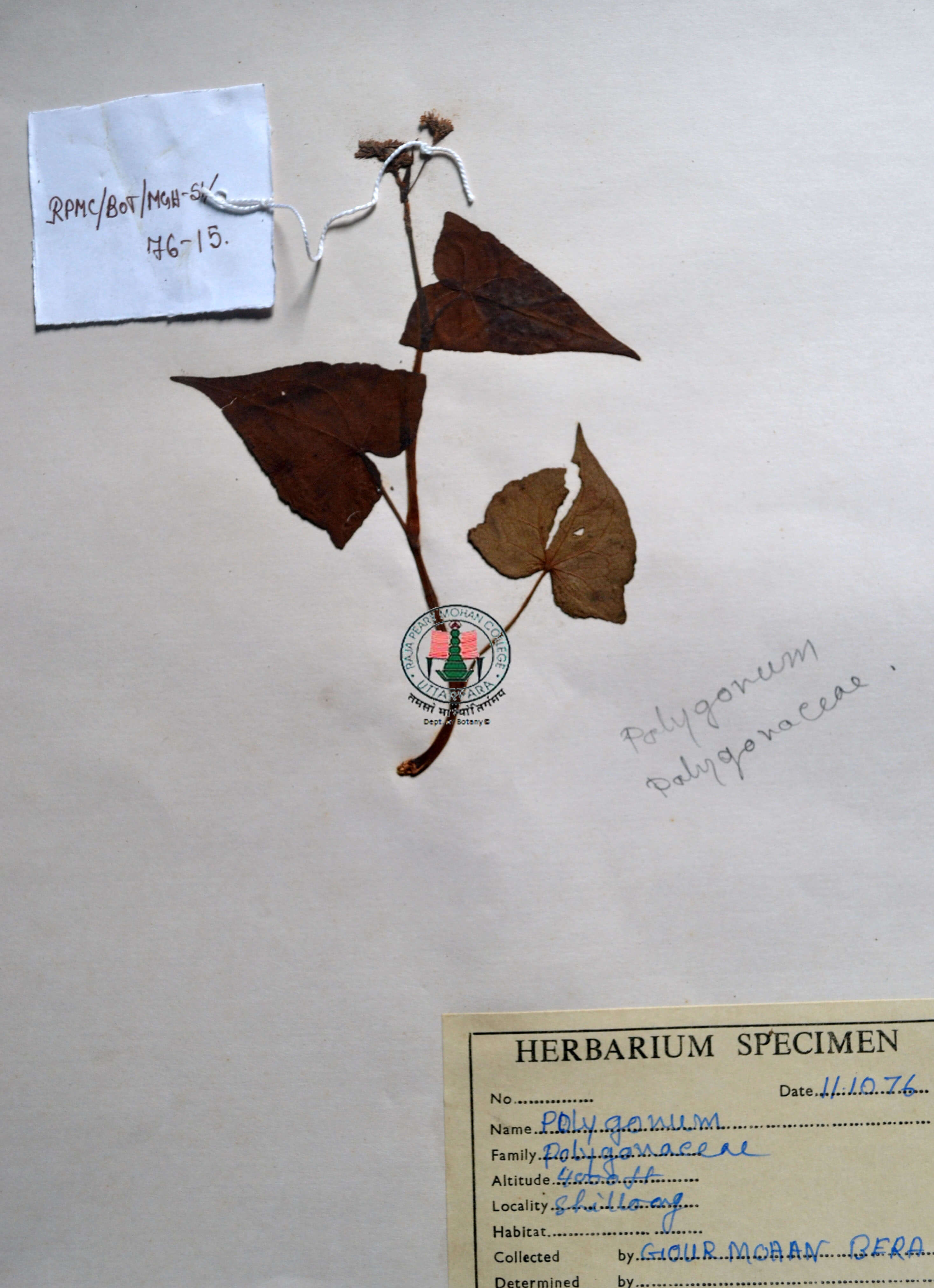
|
| 17 |
Polygonum spp |
Polygonaceae |
Erect branched herb; leaves simple, linear-lanceolate, curly at tips, alternate, ochreate-stipulate, clasping with stem; placentation basal; fruits berry
|
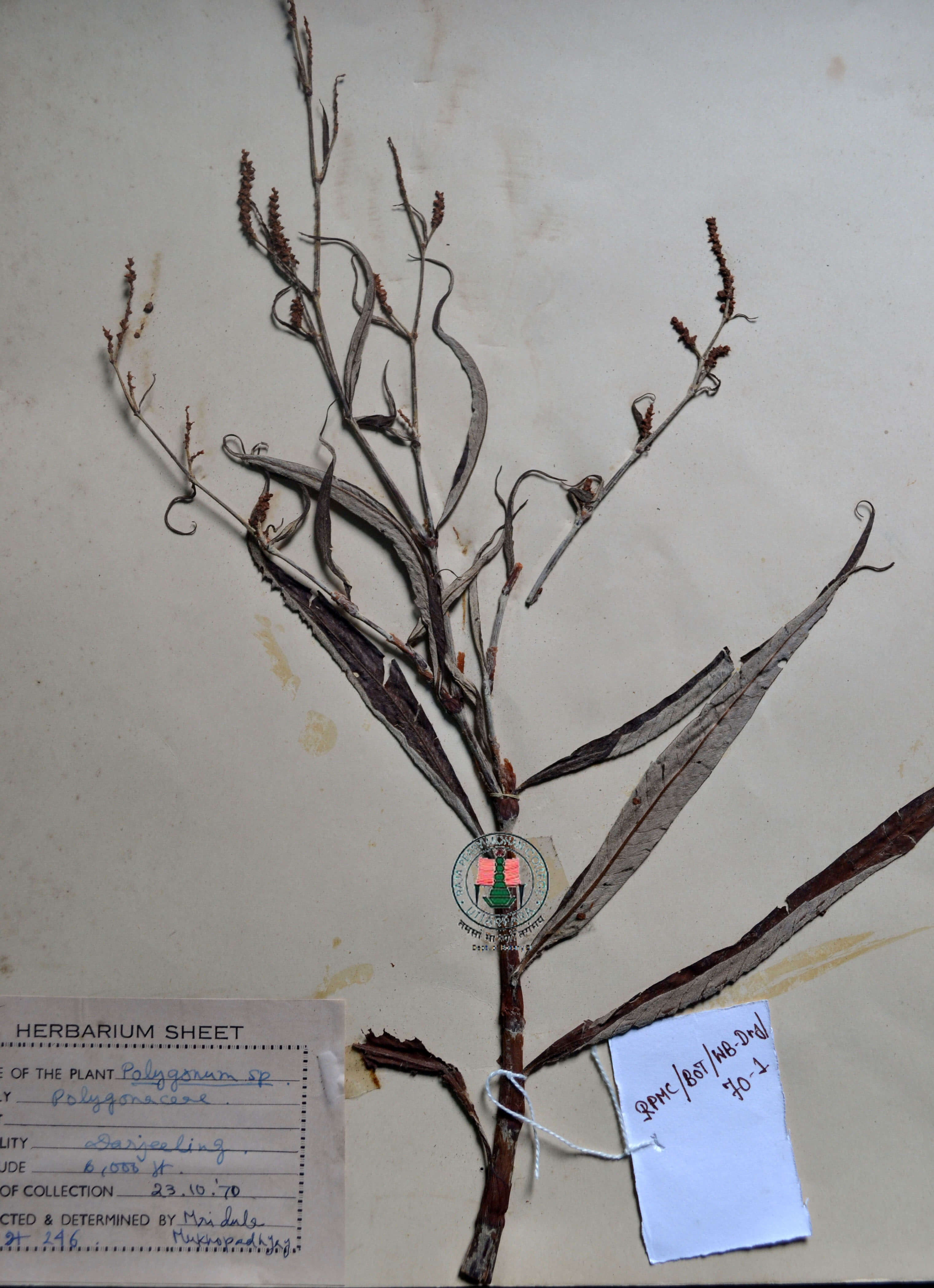
|
| 18 |
Polygonum orientale L. |
Polygonaceae |
An erect, 1-2 m tall, decumbent or prostrate simple-branched, annual, herb; stems glabrous, lineolate-canaliculate; leaves linear to linear-lanceolate, acuminate at apex, glabrous except margin, midrib and veins ciliate, sessile to subsessile, stipulate; stipules Ochreate flowers white, pedicel, arranged in a branched raceme with 1-6 spikes/ raceme, pedunculate; tepals 5, oblanceolate-obovate, obtuse, biseriate, unequal; stamens 5-8, filaments long, equal; stamens 7, exerted, ovary broadly ovate-orbicular, placentation basal, trigonous, styles three, long, filiform and free till half of the length with capitate stigmas; fruits-nuts trigonous, included in persistent perianth, black, shiny, ovoid.
|
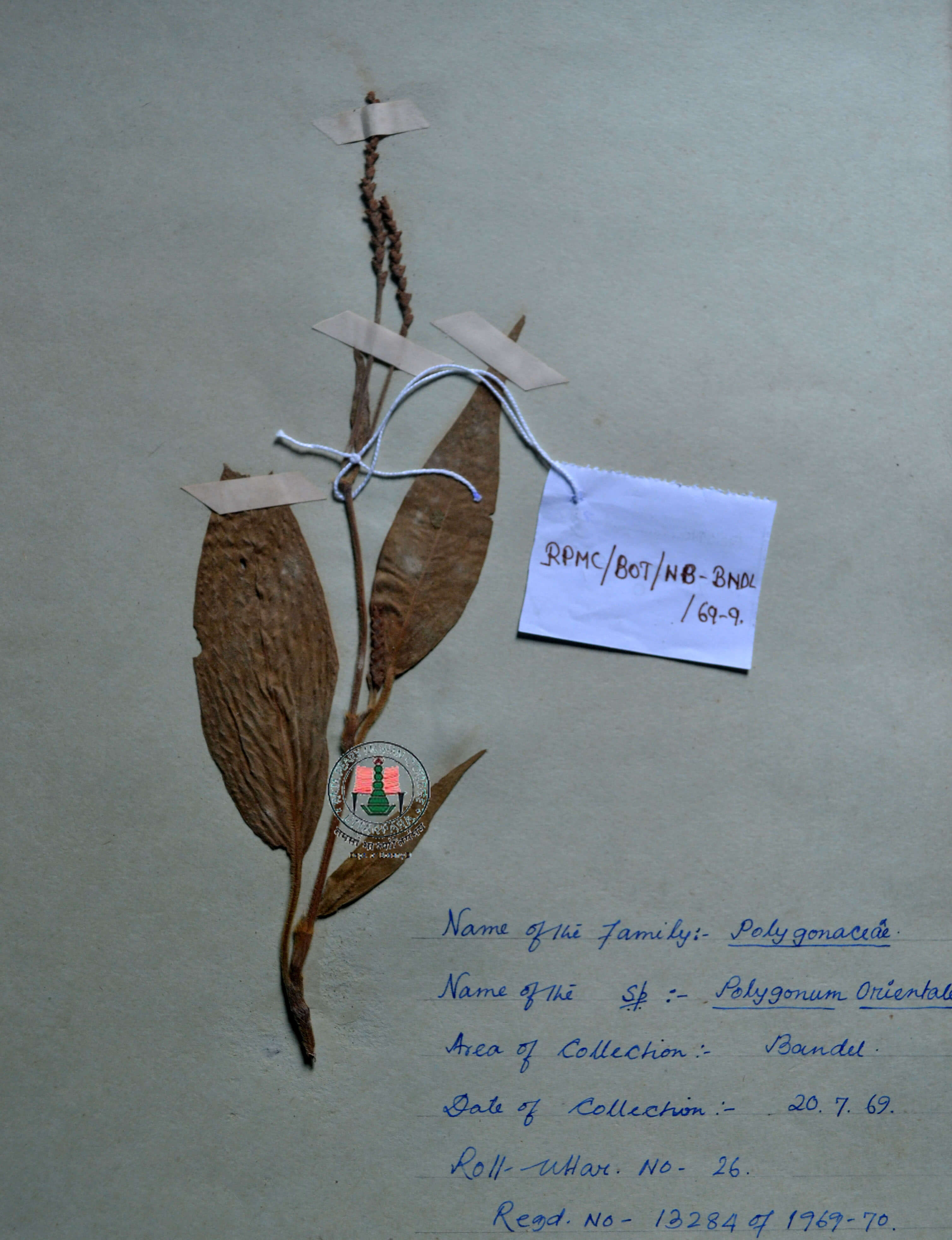
|
| 19 |
Polygonum chinense L. |
Polygonaceae |
Perennial herb/climber with stout rhizomes; stems erect, 70-100 cm tall,
branched, striate, ligneous at base; petiole auriculate at base; leaves oblong-ovate,
truncate at base, shortly acuminate at apex, alternate in arrangement, leaf uppersurface
with purple inverted ‘v’-shaped spot, ochreate; Perianth white or pinkish, 5-parted; tepals ovate, accrescent in fruit, becoming blue-black, fleshy; Stamens 8, included. Styles 3, connate to below middle; placentation basal, flowers small, white, pinkish, arranged in capitate, several capitula aggregated and panicle-like; peduncle densely glandular hairy; bracts broadly ovate; fruits berries/achene; included in persistent perianth
|
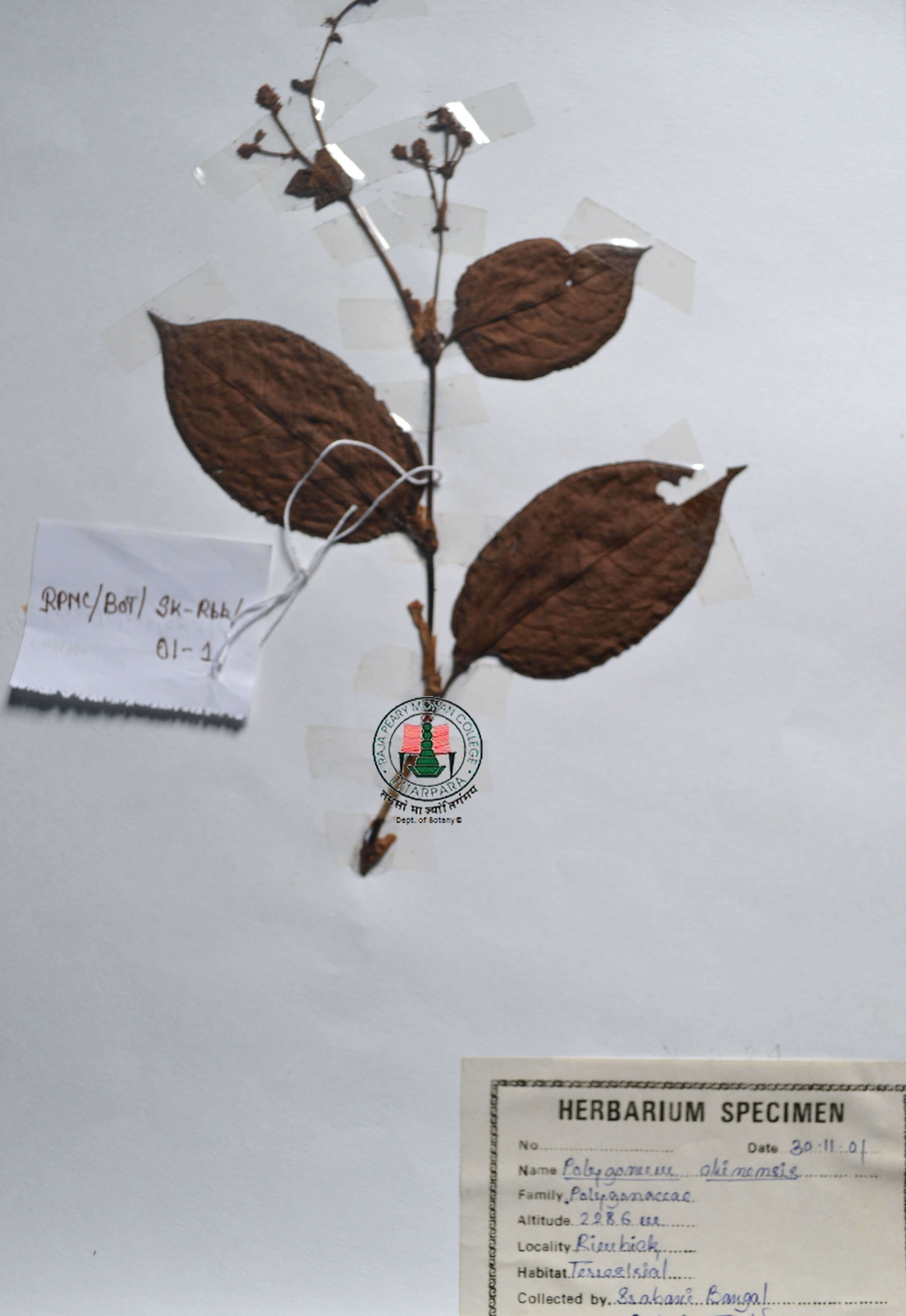
|
| 20 |
Duranta plumieri Jacq. |
Verbenaceae |
Smooth, unarmed shrub, with straggling and drooping branches, small, obovate-elliptic leaves, pointed or rounded tips and pointed base; Flowers are scentless, borne on one side of the rachis, white or lilac-blue with two violet stripes in axillary racemes with terminal panicles, spreading and slender, fruit is fleshy, ovoid, orange-yellow and 7 to 8 millimeters long.
|
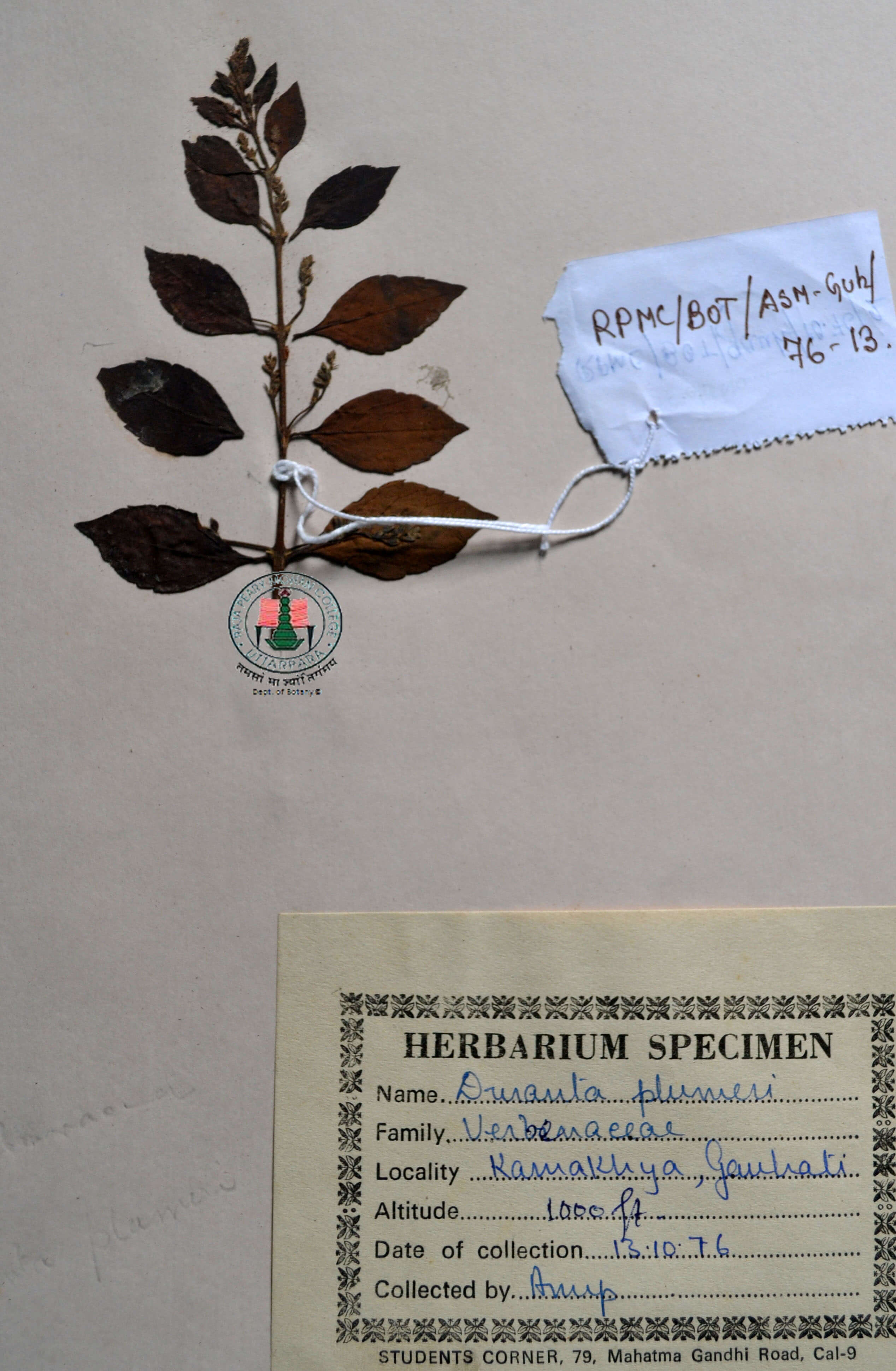
|
| 21 |
Clerodendrum viscosum Vent |
Verbenaceae |
Erect; leaves simple, opposite, decussate; petiole 2.5-8 cm long , terete, fulvous tomentose; broad elliptic-ovate or suborbicular, apex acuminate, base cordate, margin entire or dentate, subcoriaceous; inflorescence terminal panicle, up to 18 cm long, fulvous pubescent; flowers zygomorphic, pink, dimorphic. Fruit drupe, black, nearly globose seated on enlarged pinkish accrescent calyx.
|
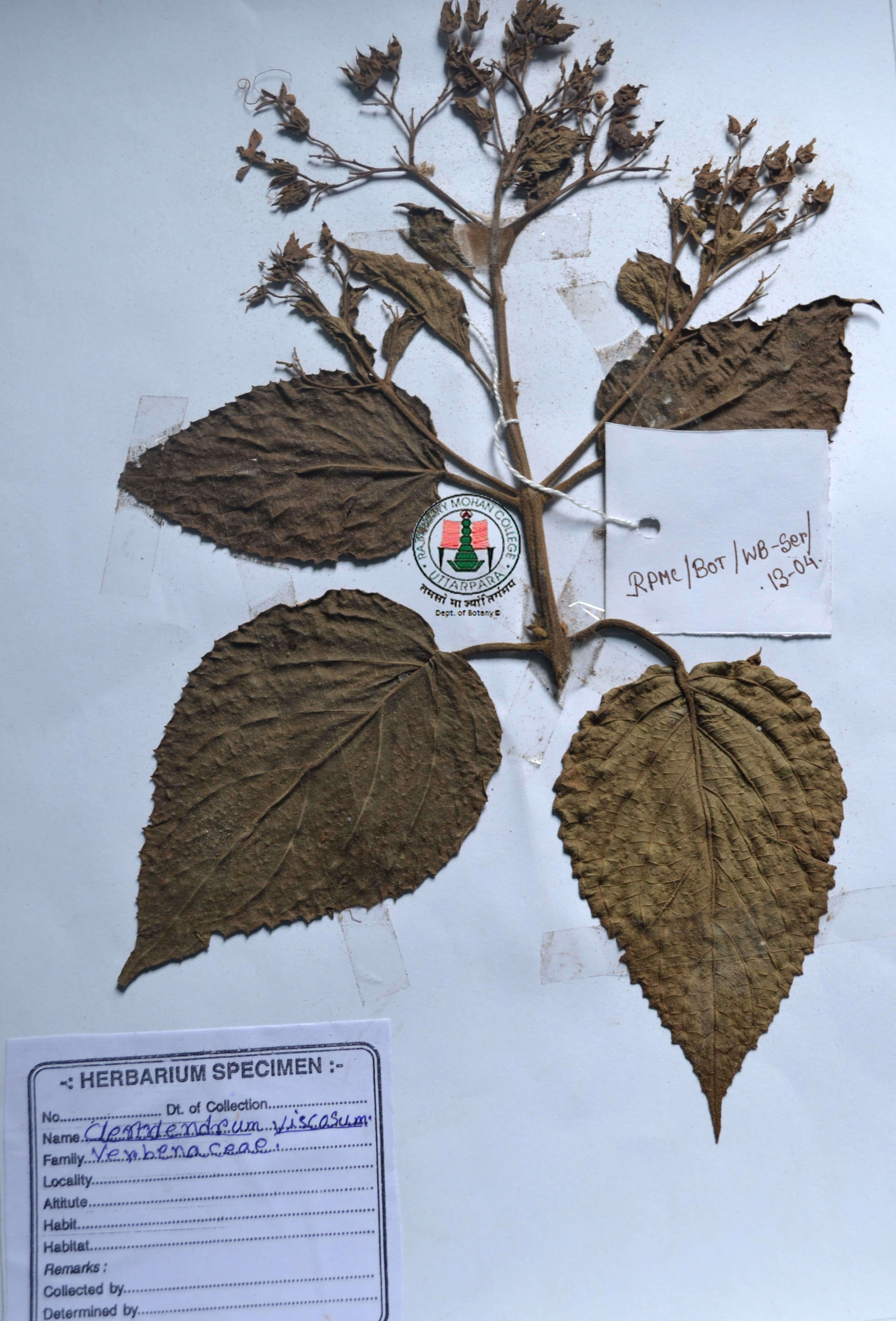
|
| 22 |
Salvia leucantha Cav. |
Lamiaceae |
A bushy evergreen subshrub, in a loose, spreading mound up to 2-4 ft tall and about the same width; leaves lanceolate, like willow leaves, puckery on top and white-wooly underneath. They are on stalks about an inch long and arranged in opposite pairs along the squarish stems. The young, fast growing stems are thick and conspicuously white-wool; blooms with white flowers 1-2 long that extend from velvety purple or lavender-blue calyces. The bicolored inflorescences are borne in very showy elongated arching clusters 6-12 in length at the ends of erect, spreading stems. At any given time, there will be just a few actual flowers per cluster, but lots of pretty purple calyxes. These inflorescences are profuse and extend way beyond the foliage, making this one of the most attractive of the salvias.
|
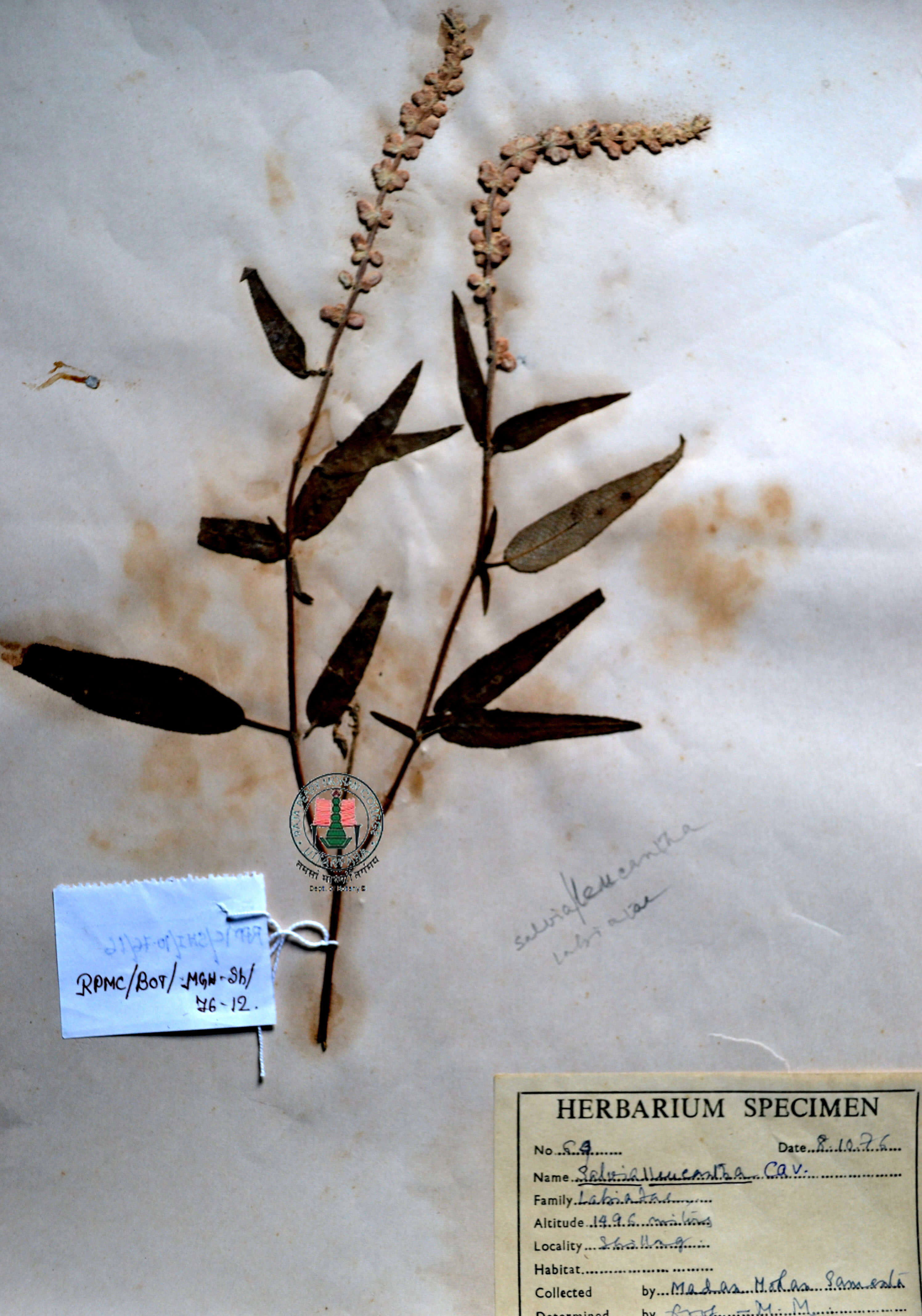
|
| 23 |
Solanum torvum L. |
Solanaceae |
Erect shrub, Stems are much branched, very prickly, and bearing compressed, stout, often recurved prickles, leaves are ovate, lobed in the margins, blunt or pointed at the tip, pointed at the base, and stellately woolly underneath. Branchlet leaves are much smaller; Flowers blue, borne in extra-axillary racemes. Calyx-lobes triangular, densely woolly, unarmed, or furnished with slender, straight spines. Corolla is broadly triangular and hairy on the outside; styles hairy. Fruit yellow, rounded, berry.
|
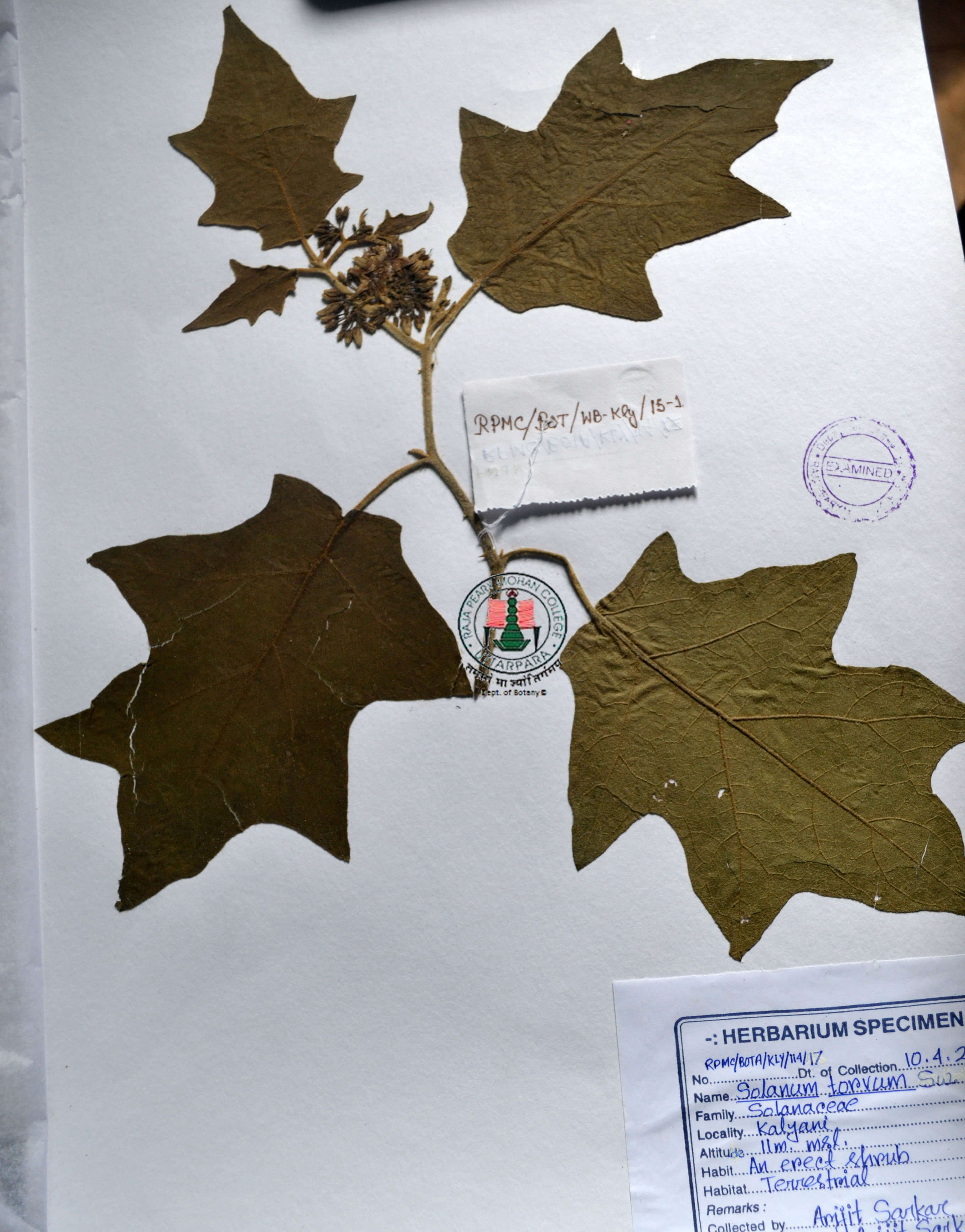
|
| 24 |
Anisomeles indica (L.) Kuntze Revis. |
Lamiaceae (Labiateae) |
Camphor-scented annual herb; erect; quadrangular pubescent stem; thin leaves, ovate, long-stalked, and pointed at the tip, with round-toothed margins. The flowers are numerous, purplish, 2-lipped (The upper lip is oblong-ovate and the lower lip has two middle lobes), crowded, and almost stalkless and occur in spike-like racemes (verticillaster), sepal cup hairy, and pointed-toothed, and the tube, long and bell-shaped, stamens didynamous; gynobasic style; fruit cercerule
|
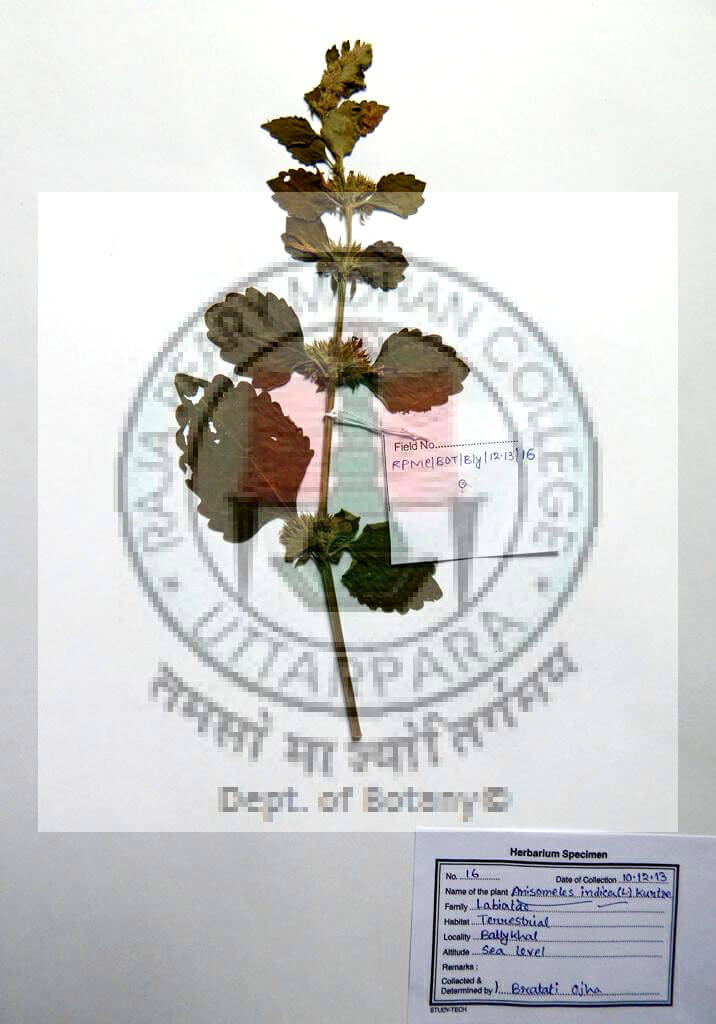
|
| 25 |
Asteracantha longifolia Nees. |
Acanthaceae |
Robust, erect annual herb, stem sub-quadrangular with thickened nodes, eaves oblanceolate, flowers pale purple-blue, densely clustered in axils, fruits glabrous, capsule.
|
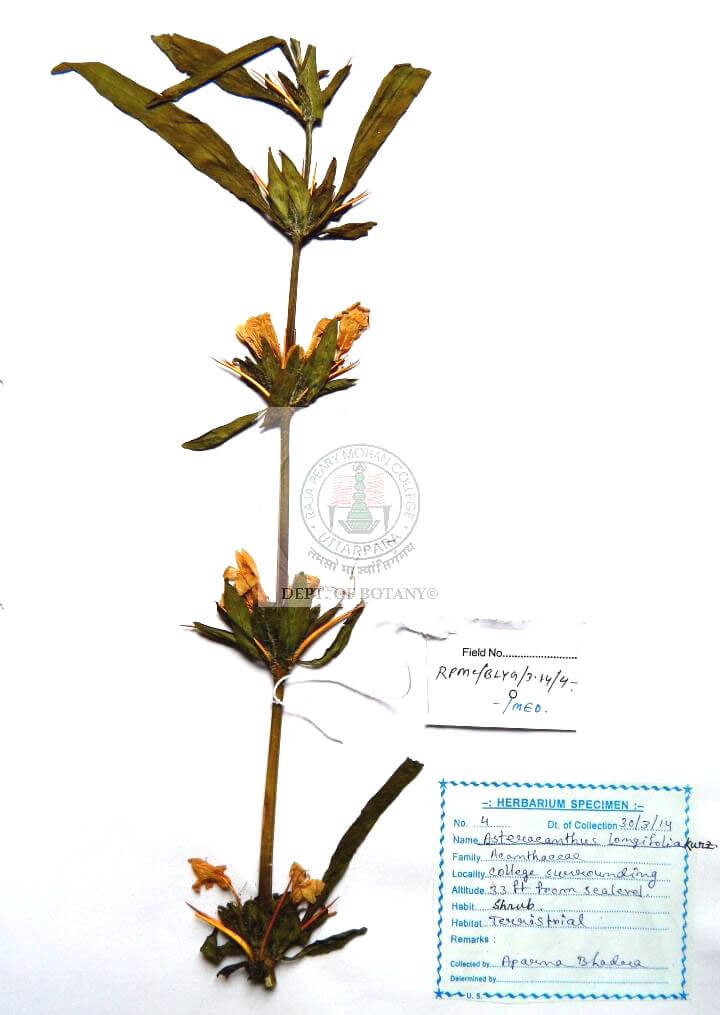
|
| 26 |
Blumea lacera (Burm.f.)DC |
Asteraceae |
Annual ,erect herb with a strong odor, stems hairy or glandular ,simple or branched, very leafy, leaves obovate or oblanceolate, smaller toward the top, stalked, and toothed or (rarely) lobulated at the margins; the bright yellow flowering heads, borne on short axillary cymes, and collected in terminal, spike-like panicles; the involucre-bracts are narrow and hairy; Fruit is an achene, oblong and not ribbed ,Pappus is white;
|
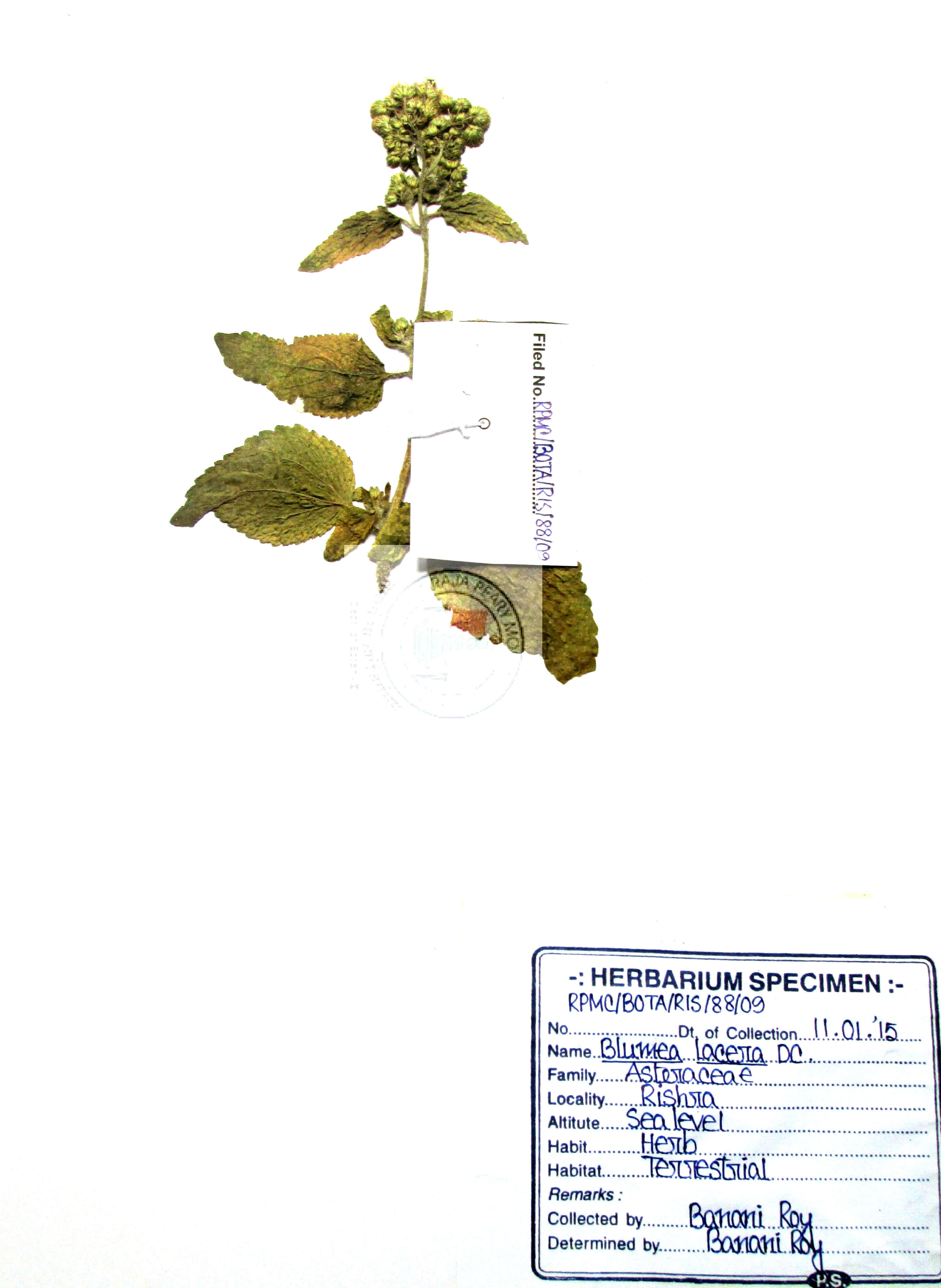
|
| 27 |
Boerhavia repens L. |
Nyctaginaceae |
Perennial herb, stem slender, leaves opposite, simple, petiolate, exstipulate, glandular hairy or glabrescent, bracteoles small, axillary inflorescence.
|
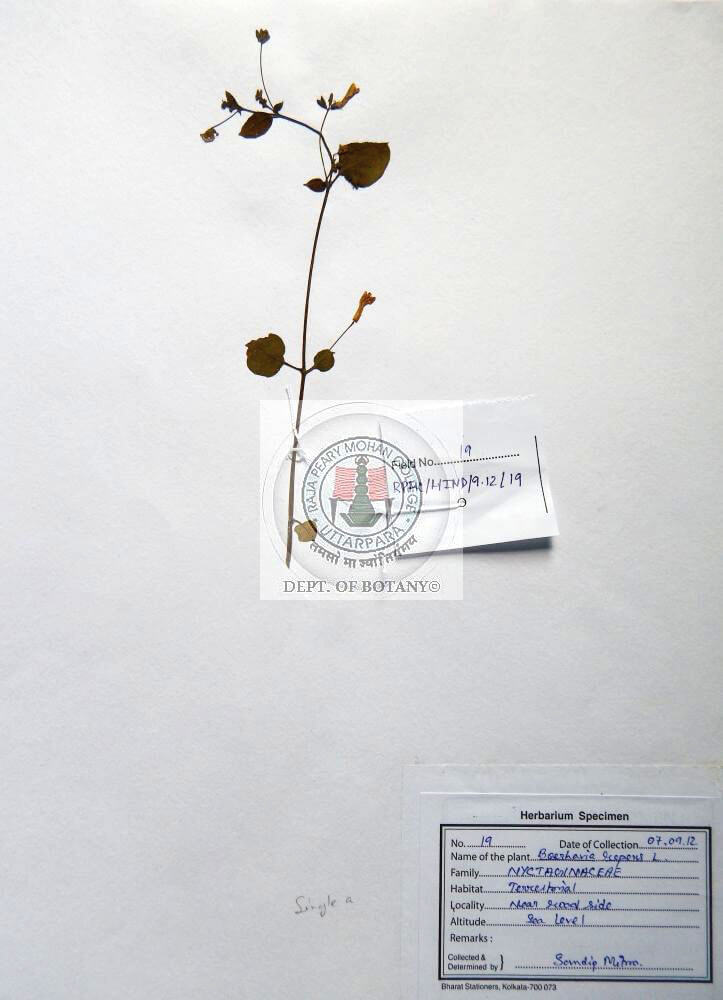
|
| 28 |
Canscora diffusa R.Br. |
Gentianaceae |
A diffuse annual herb, growing up to 15-50 cm high with many slender branches. Stalkless leaves oppositely arranged, ovate; Flowers occur in lax cymes at the end of branches. Rosy pink flowers with three visible petals. Actually there are 4 petals. Two of them merge to form a single notched petal. Four stamens emerge out of the flower; Fruit a Capsule, linear-oblong.
|
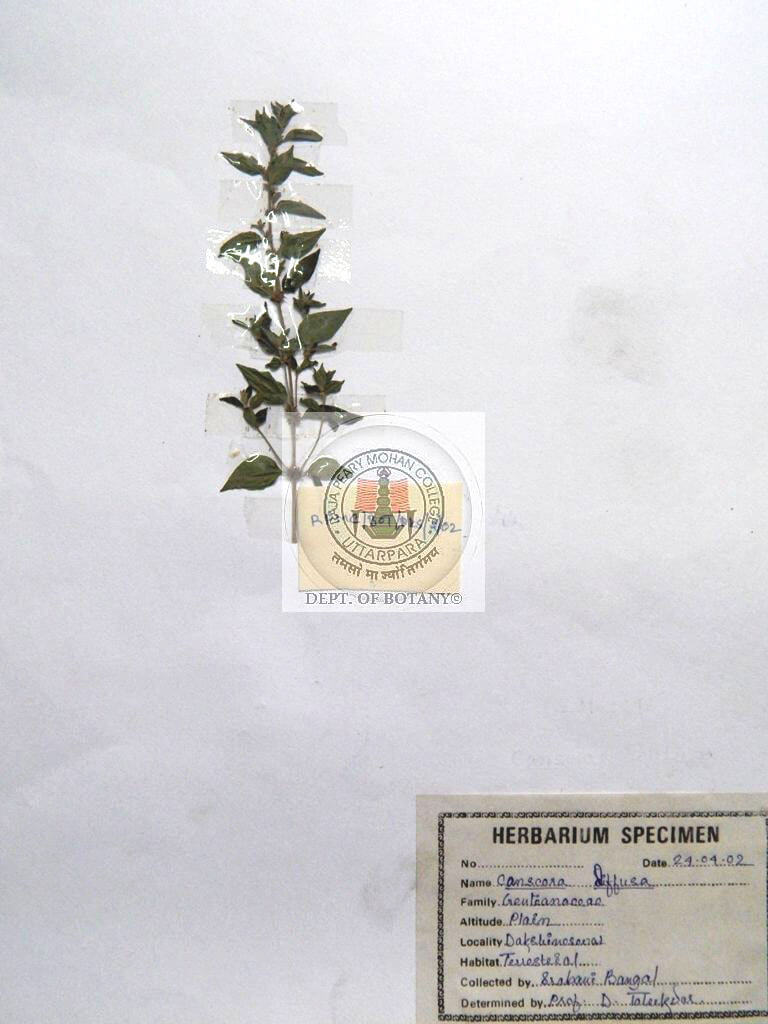
|
| 29 |
Cardiospermum halicacabum L. |
Sapindaceae |
Woody annual climbers, herbaceous many-branched vine with bi-fid (forked) axillary tendrils, borne at the base of inflorescences; leaves are ovate-lanceolate, alternate-spiral in arrangement and bi -ternately compound, essentially 3-foliolate with each part divided again into 3 leaflets; leaflets with coarse serrate teeth. Leaflets showing toothed margins, are lanceolate, faintly pubescent with pinnate venation. Obtuse-mucronate at apex, obtuse-truncate at base, irregularly deeply incised at margins; flowers white, arranged in axillary corymbose racemes, usually 3-flowered by abortion, white with a yellowish centre. Petals milky-white, obovate. Stamens as long as or slightly longer than petals; filaments sparsely long villous. Ovary obovoid or sometimes subglobose, pubescent; fruits (capsule)- Inflated, thin shelled, papery, balloon-like.
|
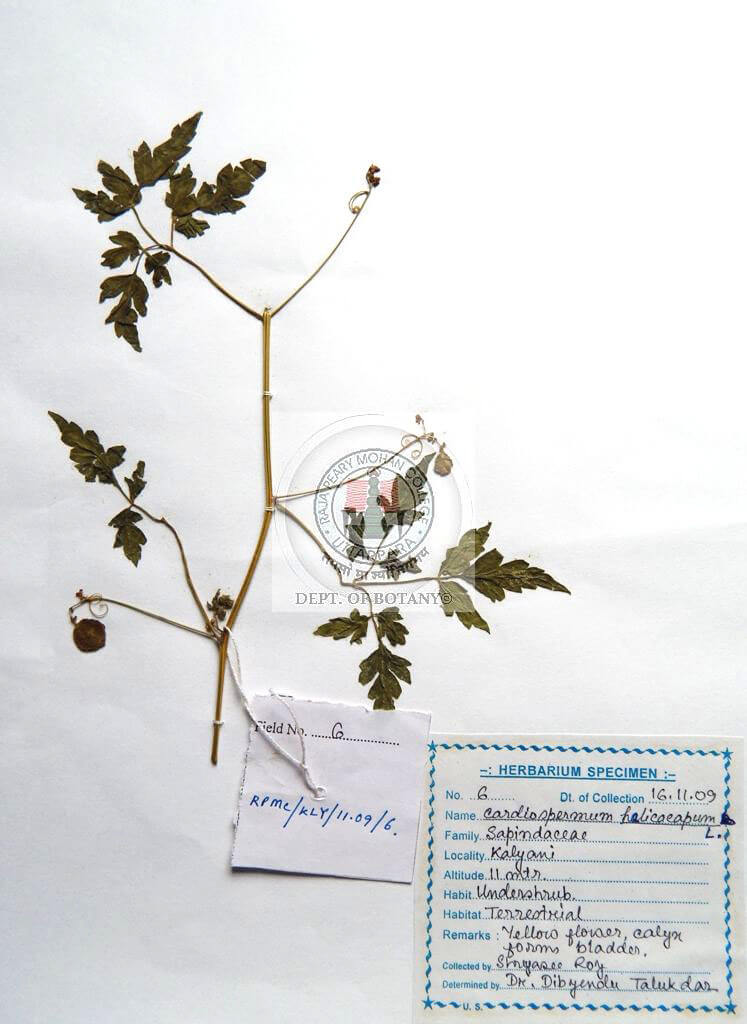
|
| 30 |
Catharanthus roseus (L.) G. Don |
Apocynaceae |
Perennial herb or a subshrub with milky latex, sprawling along the ground or standing erect up to a metre in height; leaves leathery, datrk green, arranged in opposite psairs; flowers with attractive white or pink comprise five petals spreading from a long, tubular throat; Each fruit is formed of two narrow, cylindrical follicles.
|
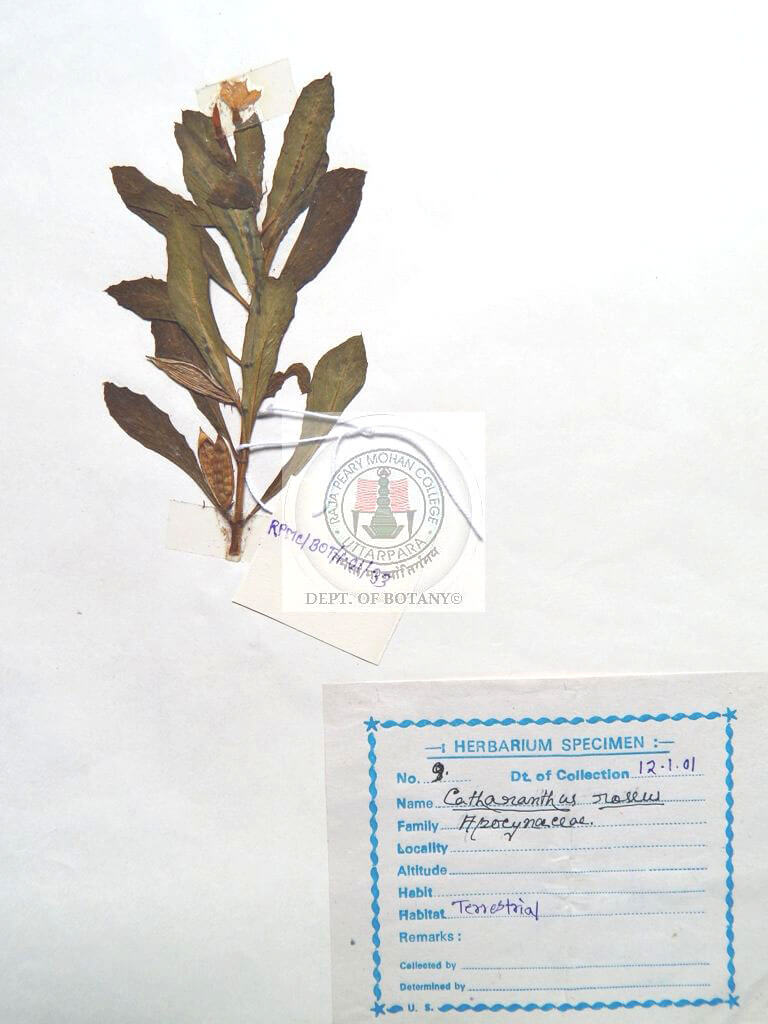
|
| 31 |
Sida cordifolia L. |
Malvaceae |
Perennial erect sub-shrub, covered with soft white felt like hair, stems and leaves are yellow-green, leaves oblong-ovate, flowers yellow, sometimes with a dark orange centre. The seeds are called as Bijabanda in Ayurveda, are grayish black in colour and smooth.
|
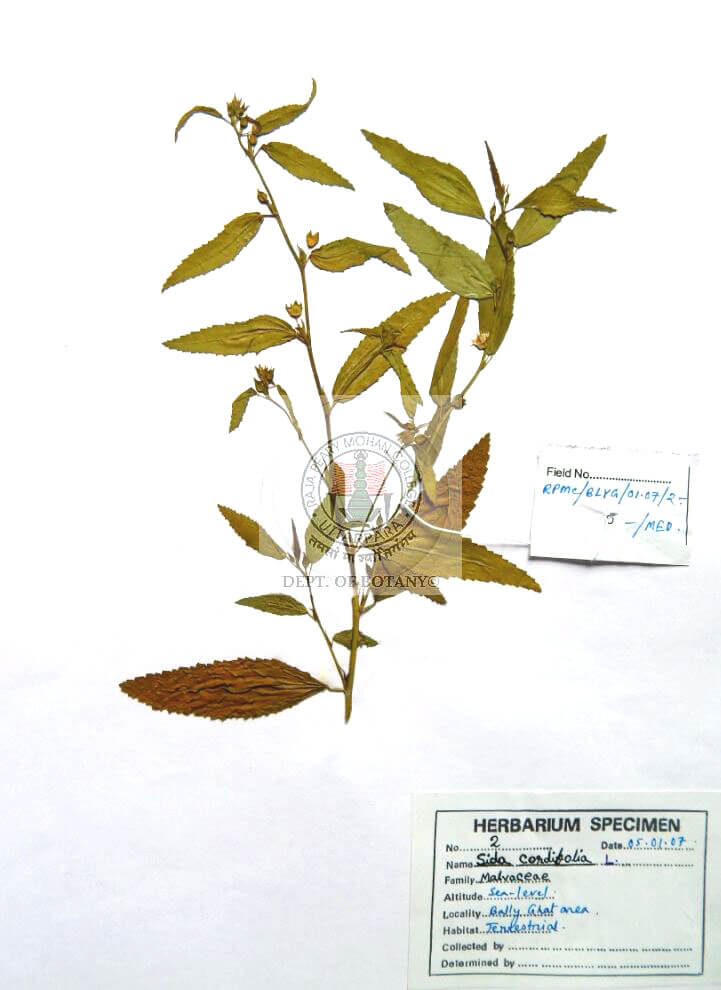
|
| 32 |
Sida rhombifolia L. |
Malvaceae |
Annual erect herb; leaf entire (untoothed), free-lateral spiny stipules at petiole base, cymose inflorescence, flowers yellow, monadelphous stamens, fruit capsule
|
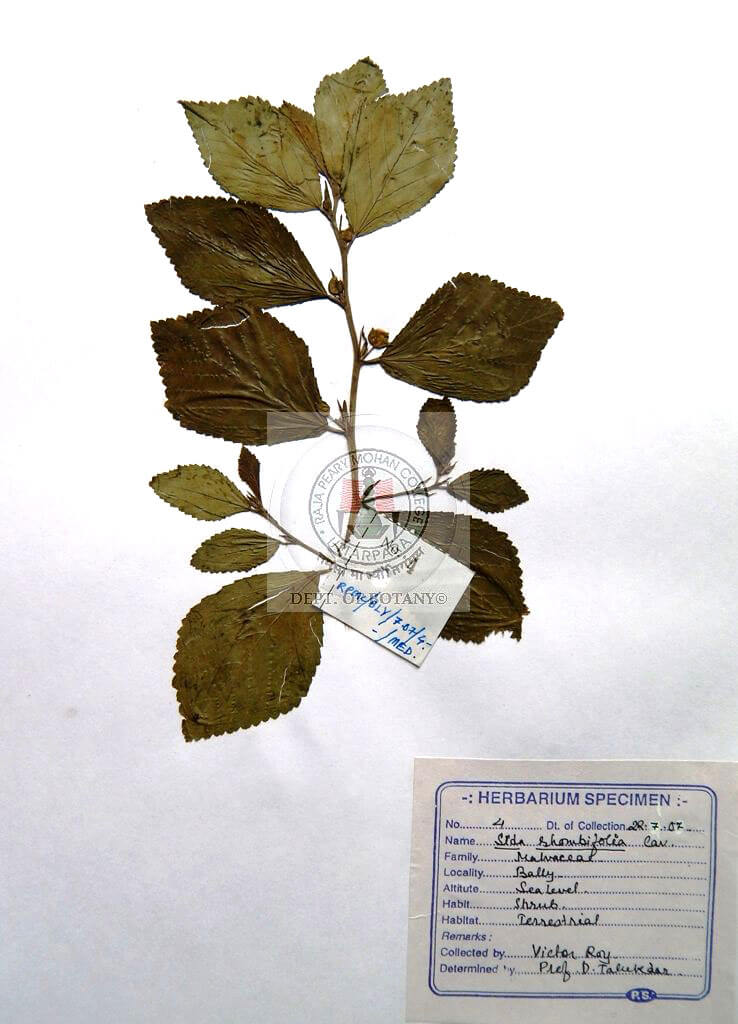
|
| 33 |
Spilanthes acmella Murr. |
Asteraceae (Compositae) |
Annual erect or ascending stout herb, leaves opposite, petiolate, broadly ovate, narrow at base, acute, axillary and terminal panicles, ray florets few, disc florets companulate, Achenes dorsally compressed.
|
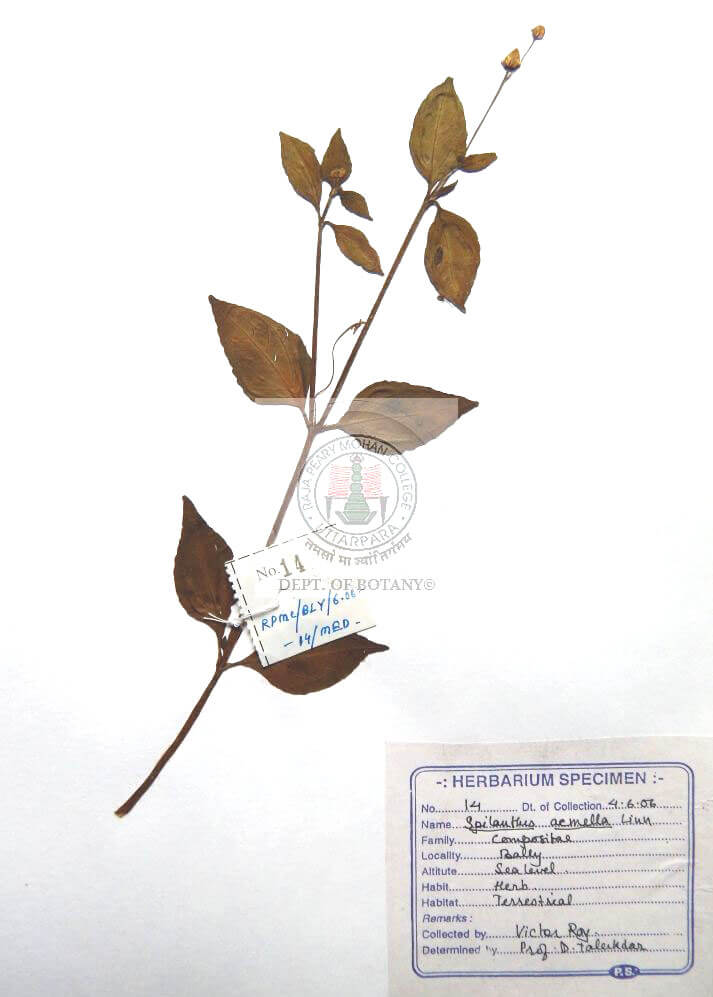
|
| 34 |
Marsilea quadrifolia L. |
Marsileaceae (Division: Pteridophyta) |
Aquatic evergreen perennial herb with dense stands, or has a random growing pattern; grows in aquatic environments from creeping, fleshing, roots containing rhizome; clumps of leaves up to 15 – 20 cm tall at intervals along rhizome. Thin green procumbent petiole rises from the rhizome to the water surface, each stalk bearing a single shamrock-like leaf with four wedge-shaped leaflets; sporocarps (spore-producing tissues) thick, grow on 1—12 mm stalks near the petiole; about 1.3--1.7 mm thick, with a distal tooth of 0.3--0.6 mm long.
|
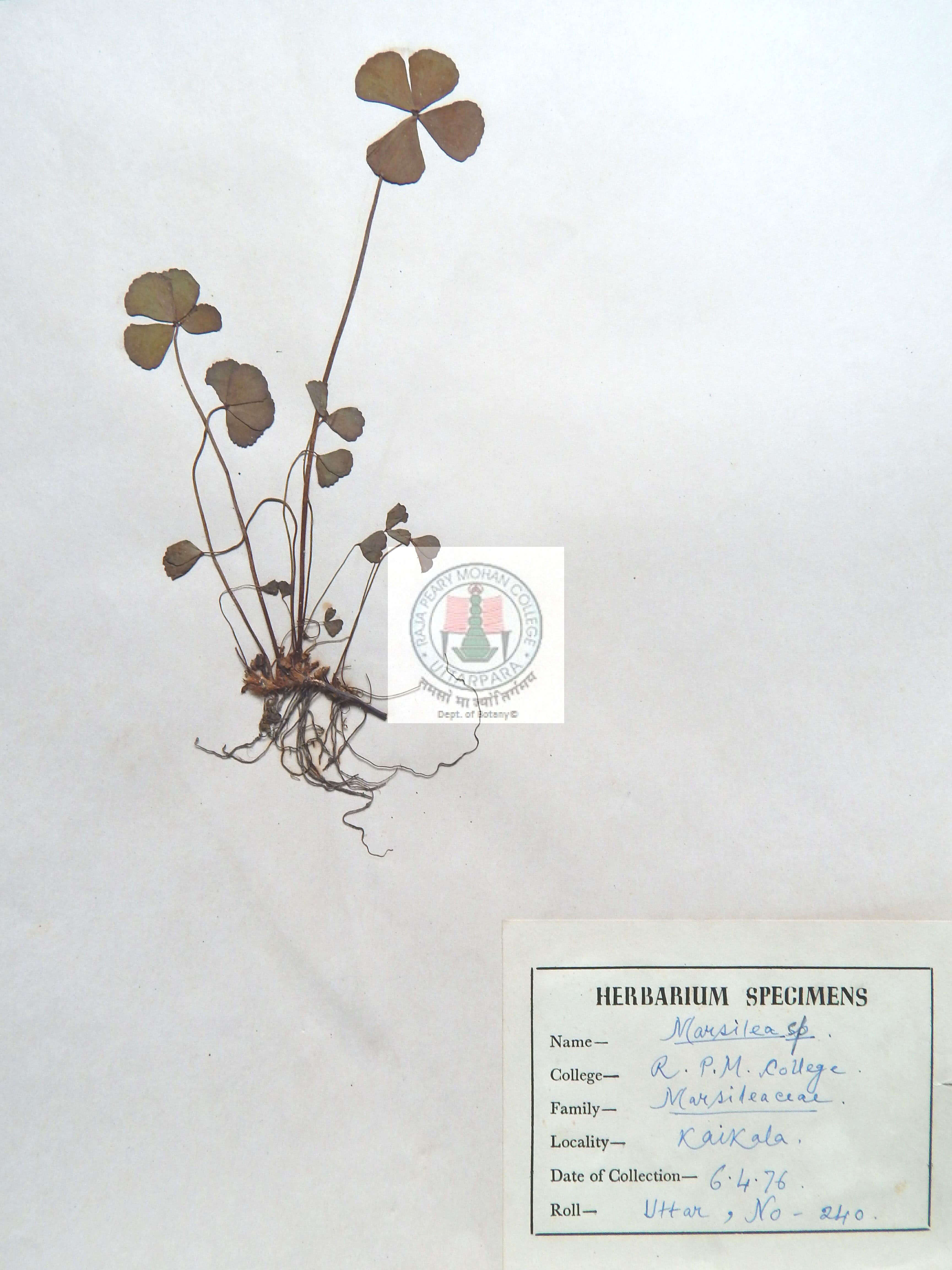
|
| 35 |
Michelia champaca L. |
Magnoliaceae (S.S) |
Tall tree that grows up to 30 m. The young branches are covered with grey hairs, ovate leaves and are up to narrowing to a fine point at the apex. Small bracts, known as stipules, are present on the leaf stalk of the alternately arranged leaves; fairly large pale yellow to orange flowers growing up to 5.1 cm in diameter, fragrant, have 15 tepals that curve up towards the tips and many stamens (pollen producing structures). The fruit- up to 3-20 brown follicles with 2-6 reddish seeds/follicle that are dry at maturity and split open at one side.
|
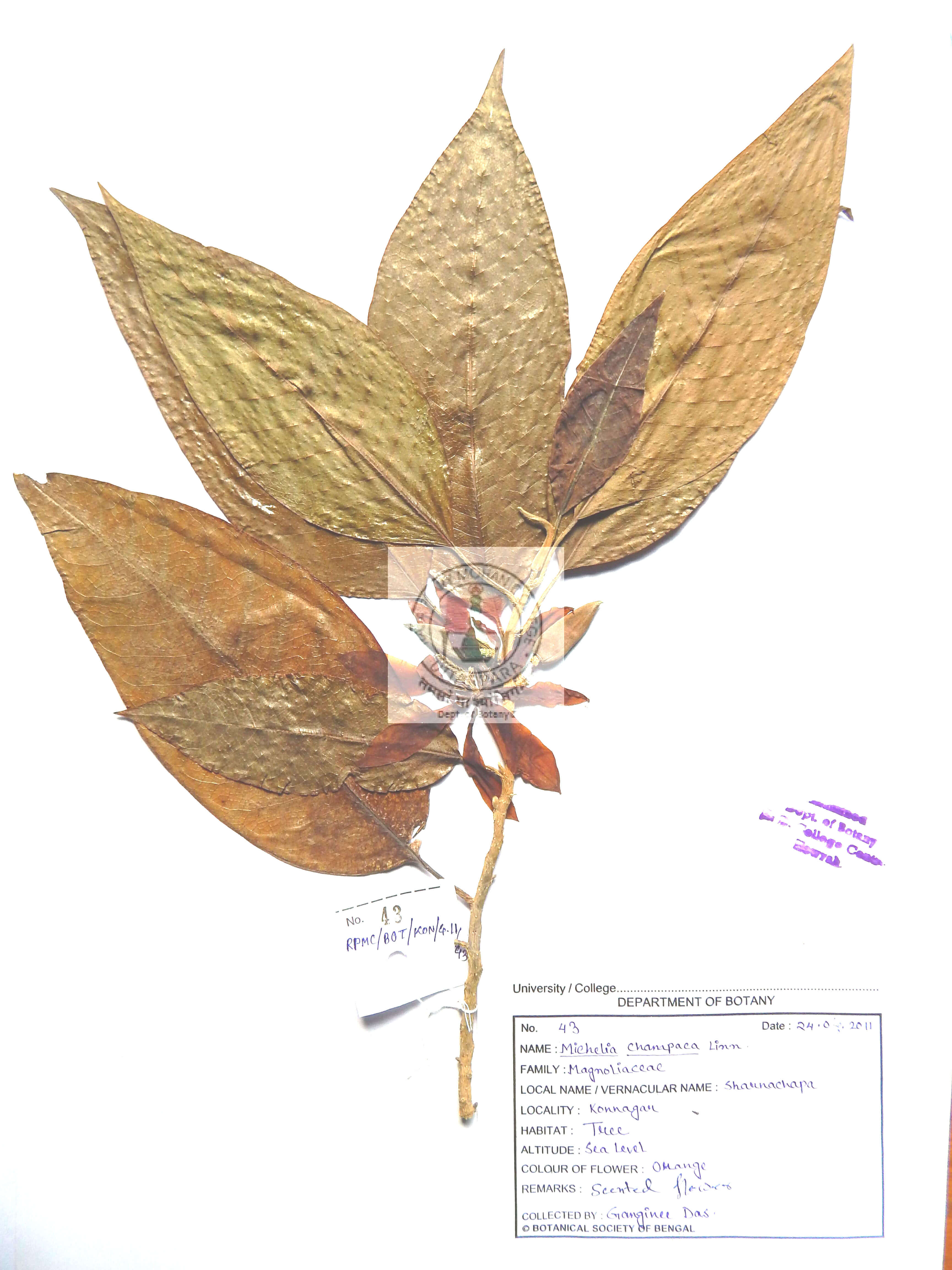
|
| 36 |
Oldenlandia corymbosa L. |
Rubiaceae |
Annual sub-erect herb; leaves subsessile, linear lanceolate, acute at apex, recurved with hairy margins, interpetiolar stipulate; tetramerous white small flowers arranged in axillary corymbose manner; stamens white, four, in the throat of the corolla; ovary 2-celled with many ovules per chamber in axile placentation; fruit capsule
|
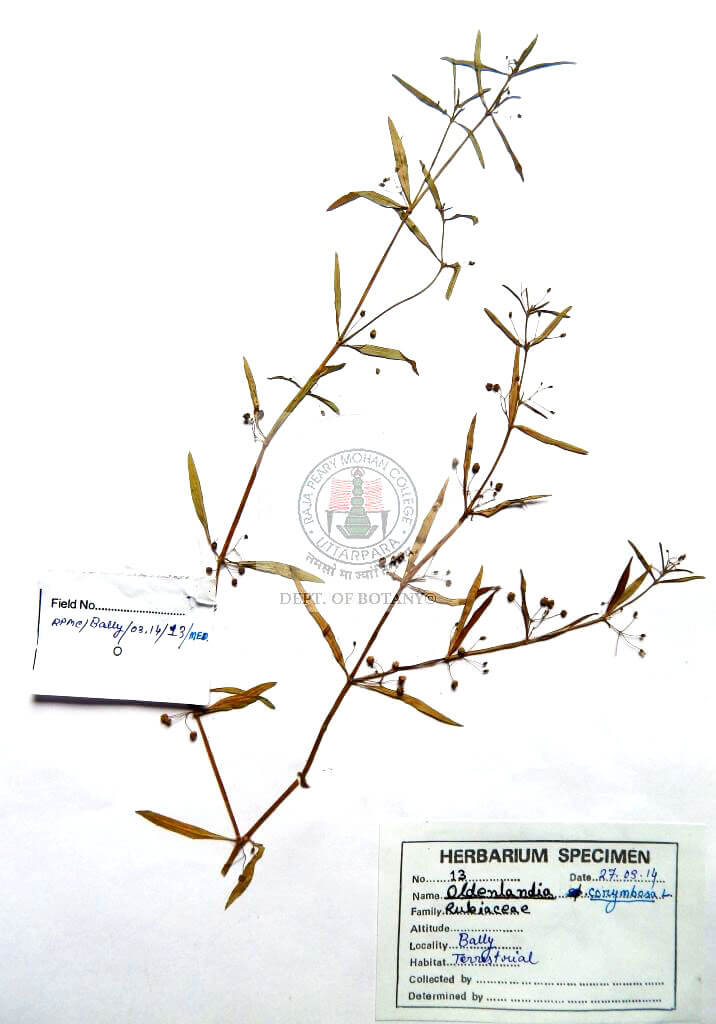
|
| 37 |
Oxyspora paniculata DC. Prodr. |
Melastomataceae |
Laxly perennial shrub with spreading and drooping branches; leaves elliptic with acute at apex with rusty star-shaped hairs underneath; flowers pinkish-purple arranged in a long pendulous pyramidal clusters; stamens are 8 in number with longer 4 show curved filaments and purple anthers and shorter 4 with yellow anthers.
|
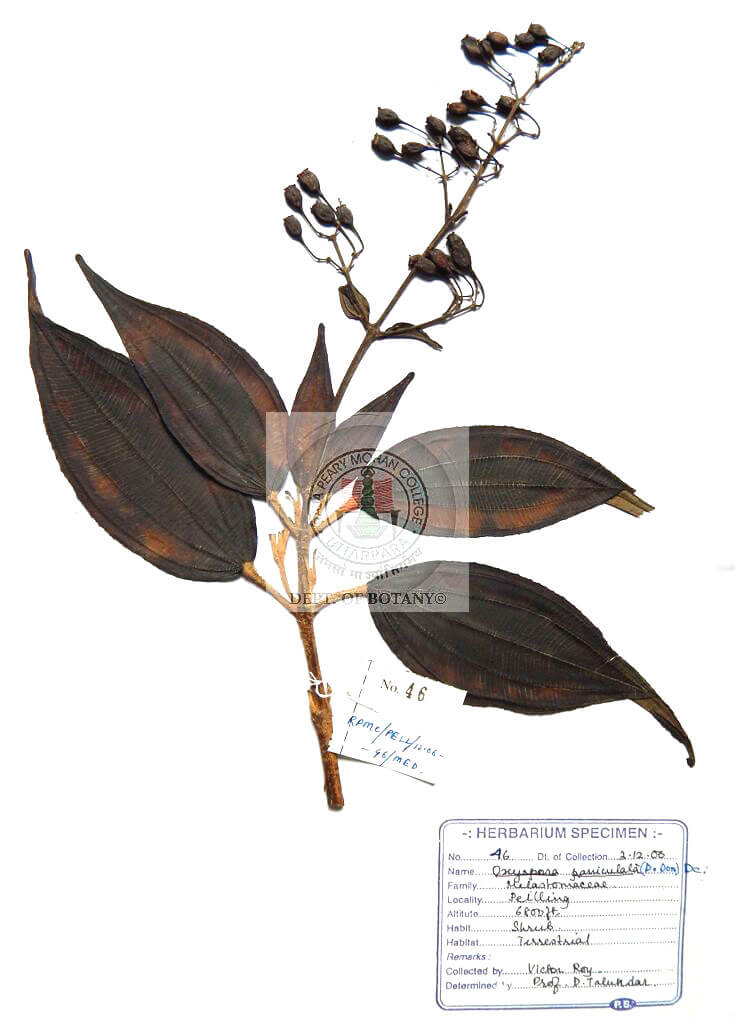
|
| 38 |
Rouvolfia tetraphyla L. |
Apocynaceae |
A small much-branched woody shrub, 0.6-1.2 m high. Leaves whorled, elliptic, medium to dark green in color, and occur in groups of 4 unequally-sized at each node, Flowers greenish white or creamy white in umbellate cymes; drupes ovoid, deep purple when ripe; pyrenes rugose, oblong and look like large pepper corns.
|
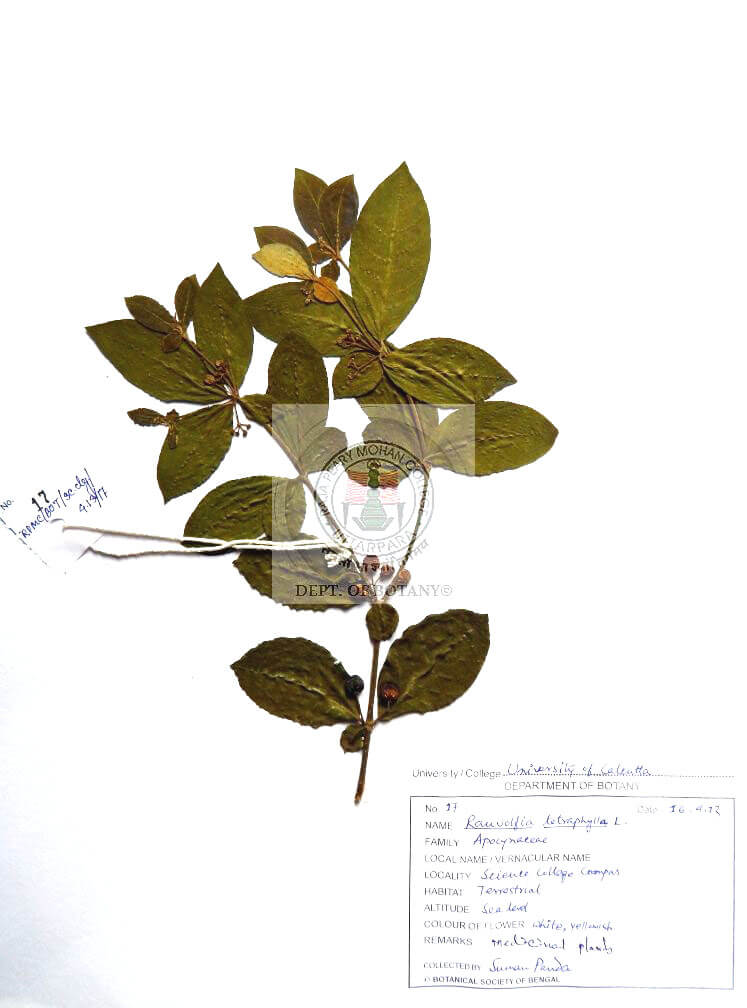
|
| 39 |
Solanum nigrum L. |
Solanaceae |
Annual erect undershrub; stems are much branched, lax; leaves are ovate, lobed or pinnatifid in the margins, pointed at the base. Branchlet leaves are much smaller; Flowers white, small, borne in extra-axillary racemes; calyx-lobes five, connate’ corolla white, widely open, connate from midway; androecium composed of five stamens, adanate with corolla, alternipetalous; anther lobes larger than filament; hairy style in gynoecium; fruit deep green-black, round, berry
|
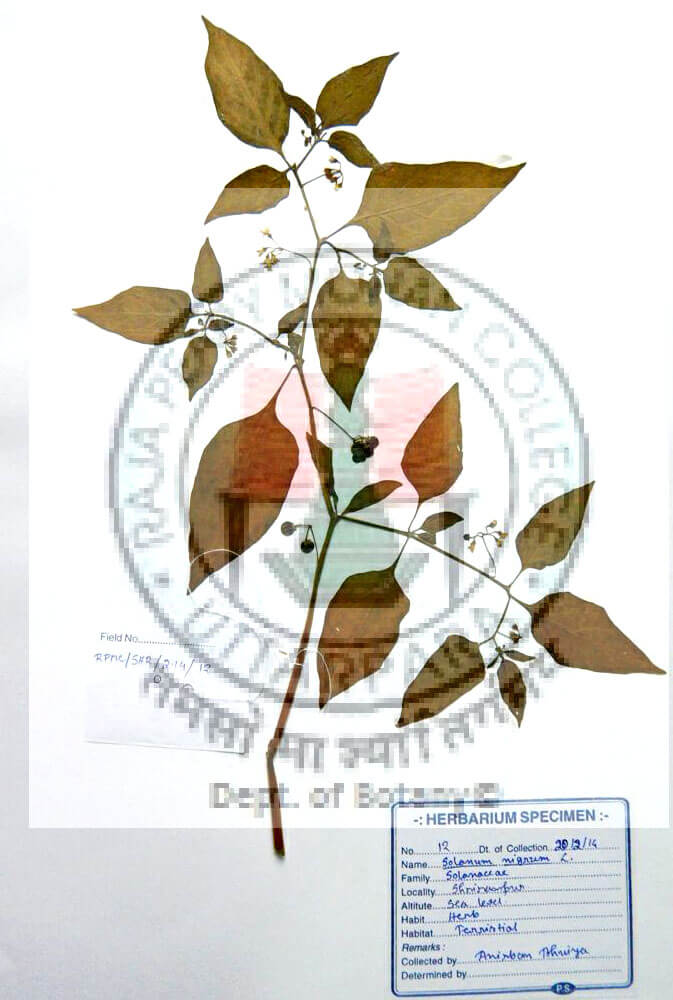
|
| 40 |
Ricinus communis L. |
Euphorbiaceae |
A suckering shrub; leaves alternate, palmate, glossy, green to purplish or reddish-green and 30 to 75 cm across, with long petioles; monoecious flowers without petals, male flowers with creamy stamens, female flowers at the tip of the spike; capsule large, oval and greenish; fruit capsule- each capsule contains three seeds that look like fat, swollen dog ticks and are deadly poisonous
|
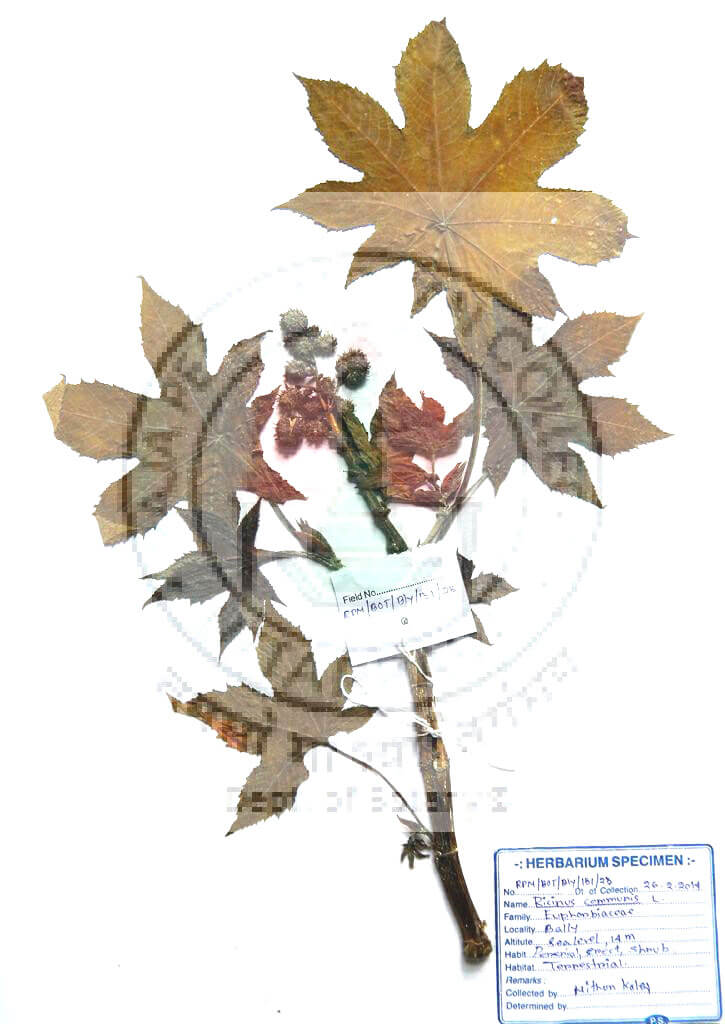
|
| 41 |
Eclipta alba L. |
Asteraceae (Compositae) |
Perennial herb, erect or prostrate, grows upto 30-40 cm in height. Stems: green or purple, bristly, thickened at the nodes. Stems are erect or prostate, entirely velvety, often rooting at nodes, oblong, lance-shaped; leaves opposite, sub-sessile, lanceolate-oblong, denticulate, hirsute on both sides; flowers white in axillary or terminal head, the female radiated, the bisexual in the centre; achene 3-angled, slightly flattened.
|
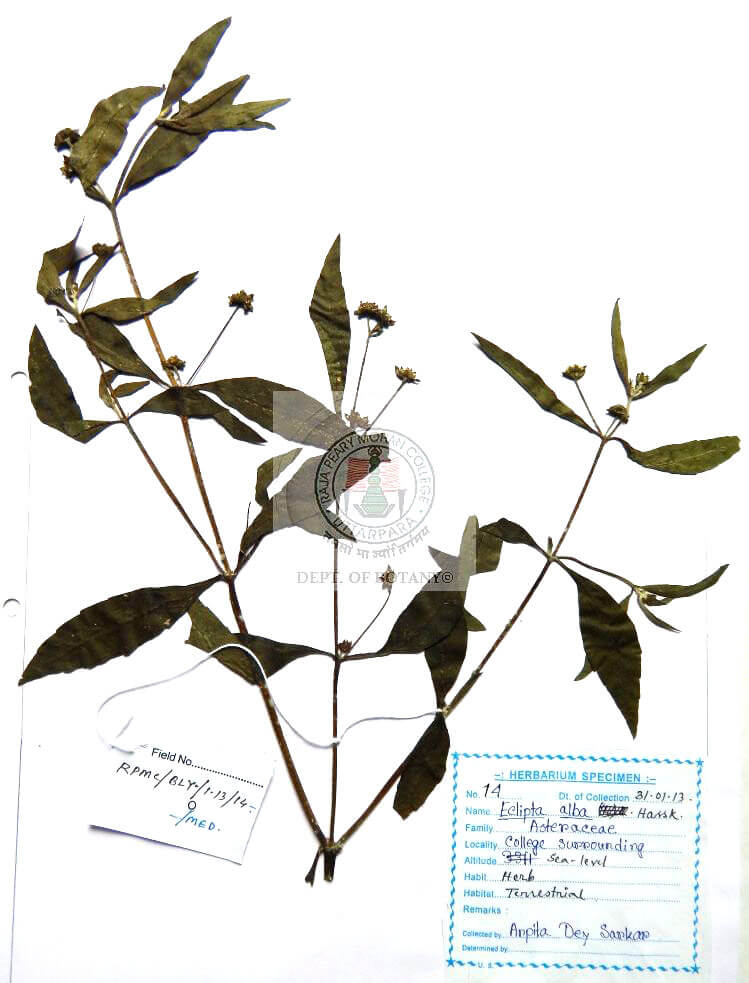
|
| 42 |
Elsholtzia blanda Benth. |
Lamiaceae (Labiatae) |
Annual herb with an erect stem; stems and branches are velvet hairy, leaves elliptic to elliptic-lanceolate, glandular, acuminate at apex, serrate at margins; flowers white, 3-4 mm, bristly outside, funneliform, throat up to 2 mm wide, arranged in spike inflorescence as verticillaster, bracteate; flowers bracteates; corolla white in colour; calyx cylindric, stamens exserted, anterior 2 potruding, posterior 2 longer, epipetalous, didynamous, palcdentation axile, gynobasic style; elliptical nutlets
|
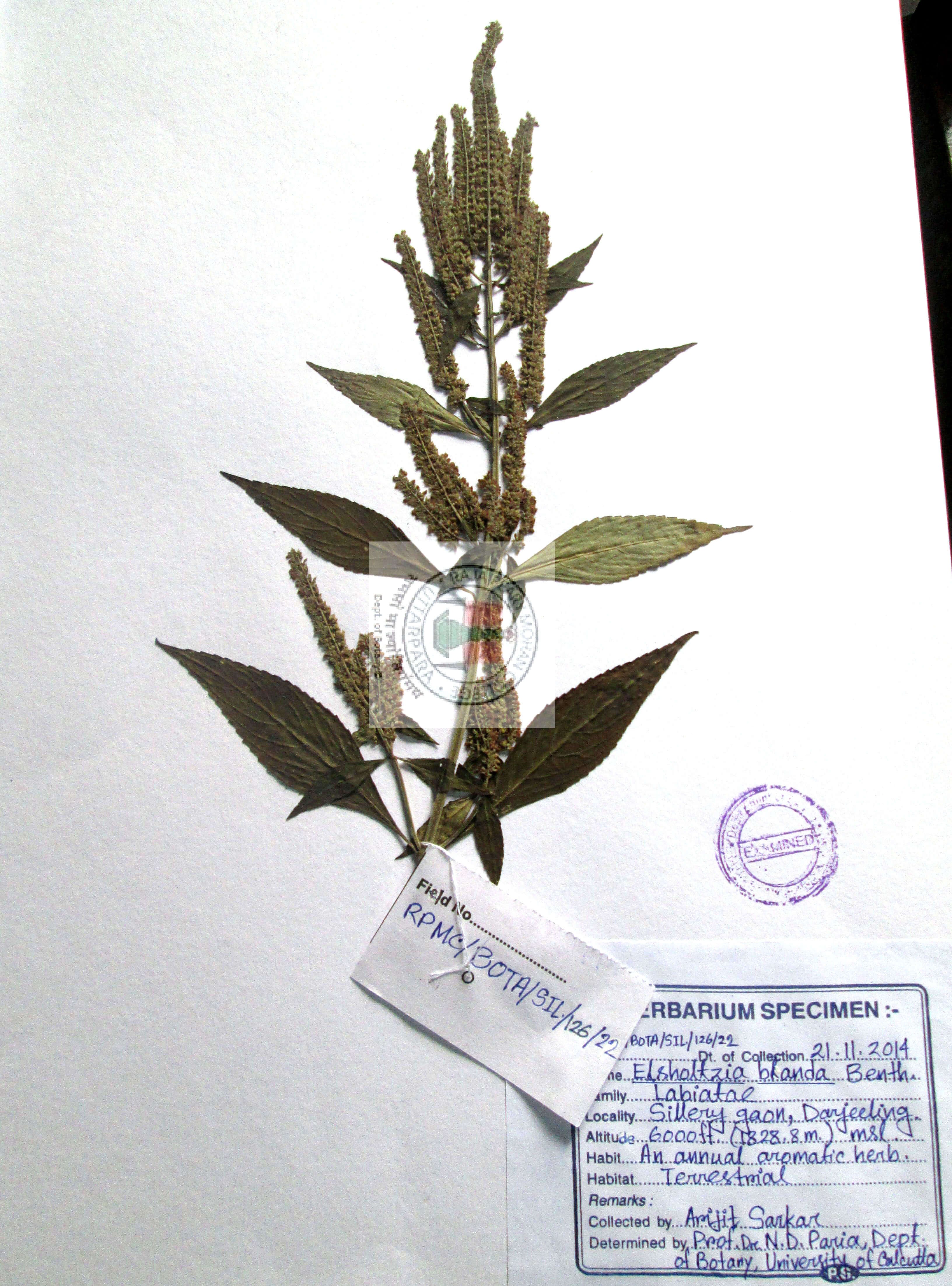
|
| 43 |
Justicia gendarussa Burm.f. |
Acanthaceae |
A perennial evergreen undershrub, 60-150 cm, with terete (neither striate nor angular) glabrous, dark purple twigs; leaves with up 1 cm long petiole; lamina linear-lanceolate, glabrous on both sides, entire at margin, acute-acuminate at apex, attenuate basally; tapering into rounded apex and glabrous and shining with prominent purple veins beneath; stems quadrangular, thickened at and above the nodes and internodes; inflorescence terminal or axillary spikes bearing flowers; flowers irregular, bracts and bracteolate, bisexual, sessile, white with pink or purple spots inside and red in the throat and lip; Corolla 2-lipped, tube cylindrical, glabrous, upper lip 8 mm long, shallowly 2-lobed, lower one 1 cm long, 3-lobed, spreading. Staminal filaments approx. 5 mm long, anther lobes unequal. Ovary oblong-cylindric fruits capsule-club-shaped, about 12 mm long, and smooth.
|
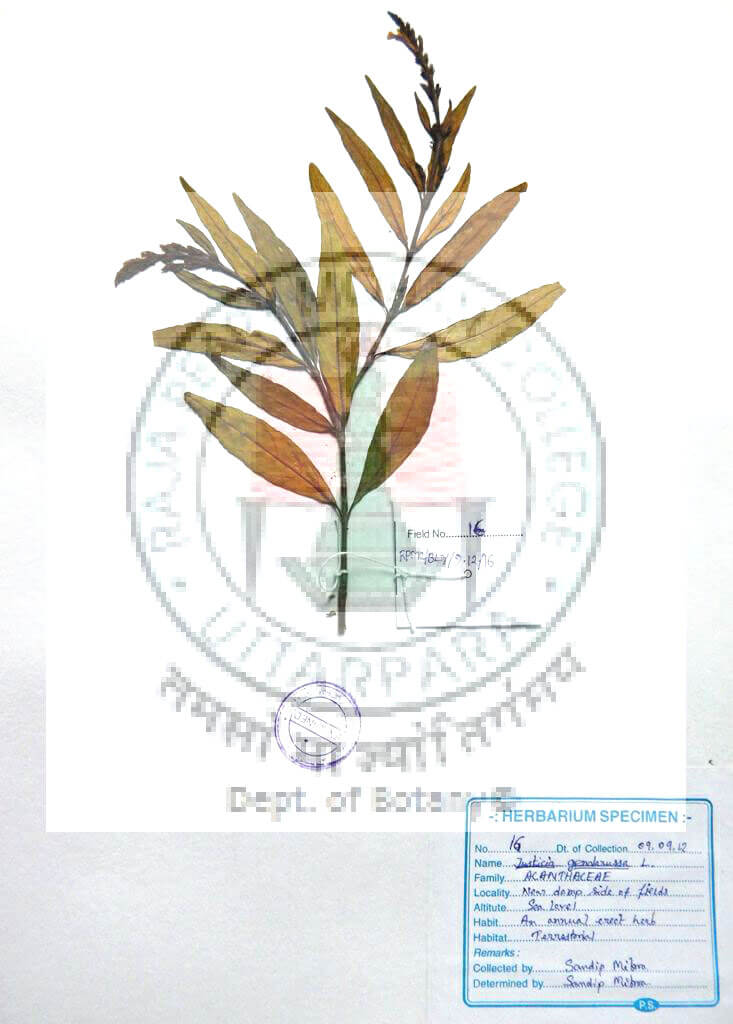
|
| 44 |
Quisqualis indica L. |
Combretaceae |
A large climbing shrub; young shoots downy; leaves petioled, oblong, leave-apex acute; flower pentamerous, showy, fragrant; calyx hairy; the style united with the calyx-tube; fruit ellipsoidal in shape with five lengthwise wings; seeds black
|
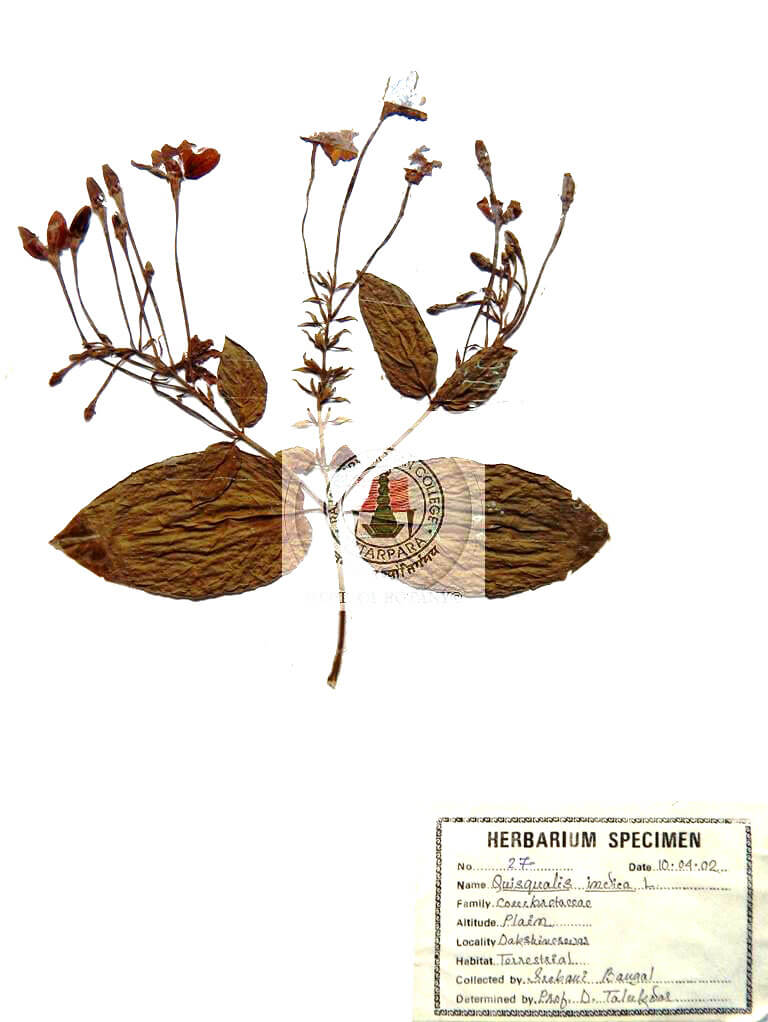
|
| 45 |
Gomphrena celosioides Mart. |
Amaranthaceae |
Perennial herb, decumbent, branched from the base; stem solid, white, villous; leaves elliptic to lanceolate, opposite, white-grayish hairy especially towards the apex; acute to obtuse at apex, round at base; flowers small, white, papery, wolly arranged in terminal cylindrical spike, lowers are hidden among the white, petal-like bracts; fruits achene-one seeded
|
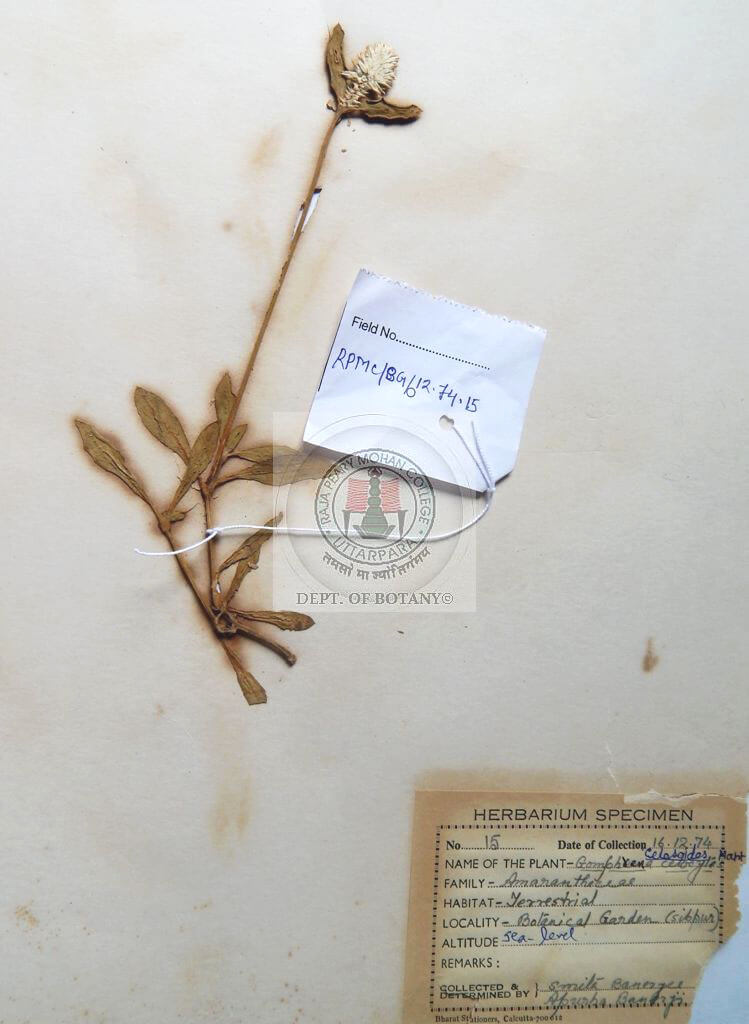
|
| 46 |
Gnaphalium indicum L. |
Asteraceae (Compositae) |
An annual erect ascending, wooly annual herbs, grows up to 0.15 m, ; leaves sessile, semi-amplexicaul at base, oblong, spathulate or oblanceolate, woolly on both surfaces, obtuse at apex, sometimes mucronate, entire at margins, those at apical nodes linear-oblong, acute at apex; flowers arranged in capitula borne in dense terminal corymbs, golden-yellow, glistening; involucre bracts shining, straw-coloured, sub-herbaceous at base and transparent towards apex, outer ones ovate, sub-acute, inner linear, acute or sub-acute. Ray-florets: numerous, pappus shorter than the involucre. Disc-florets: slender; style-branches truncate; fruits cypsela oblong, papillose; Achenes are tubercled or have minute curved bristles
|
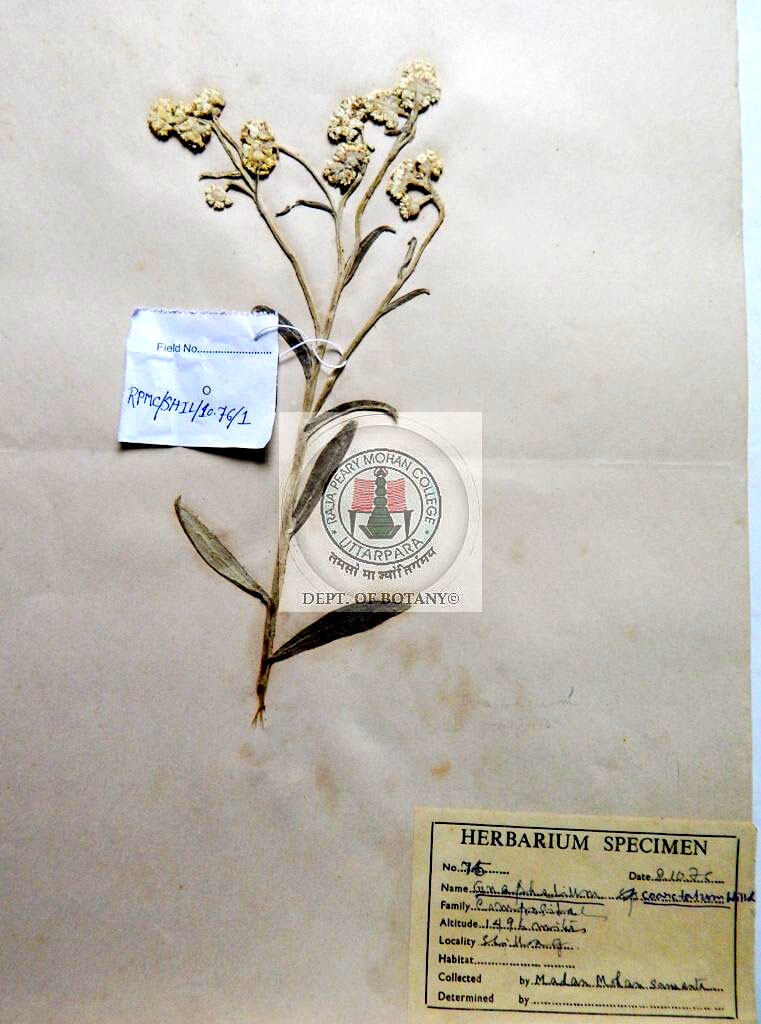
|
| 47 |
Trifolium pratense L. |
Fabaceae (Leguminosae) |
Perennial herb; stem ascending, erect, branched; leaves alternate, stipulate, compound, often in three leaflets, leaflets lanceolate-elliptic, entire to finely toothed at margins often with white botches, stipule bristled; flowers irregular, calyx 5-lobed; corolla 5, violet-red, vexillary in aestivation, stamens 10, monocarlellary gynoecium; fruits pod
|
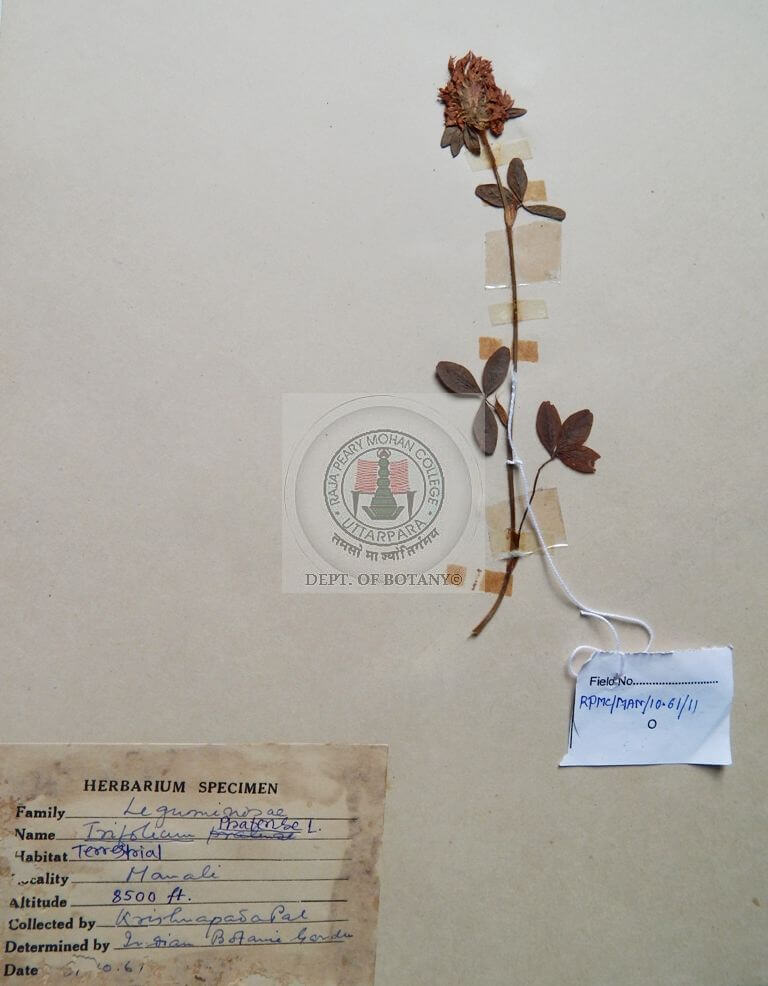
|
| 48 |
Gymnopetalum cochinchinense (Lour.) Kurz. |
Cucurbitaceae |
Monoecious climbing herb, stems slender, angular, sulcate, scabrous-hairy; tendrils simple, filiform. Leaves membranous; scabrous, ovate-cordate, angled; base deeply cordate; apex acuminate; margin undulate, sparsely dentate; probract absent. Male inflorescence raceme; bracteates; flowers solitary, peduncle long, bract prominent, obovate, incise-serrate. Male flower solitary; calyx tube elongate, villous, wider at apex; sepals linear; stamens-3, inserted. Female flower solitary, in the same or different axil as male inflorescence. Ovary pubescent; narrowly ellipsoid. Stigma 3. Fruits are ovoid-oblong and ribbed
|
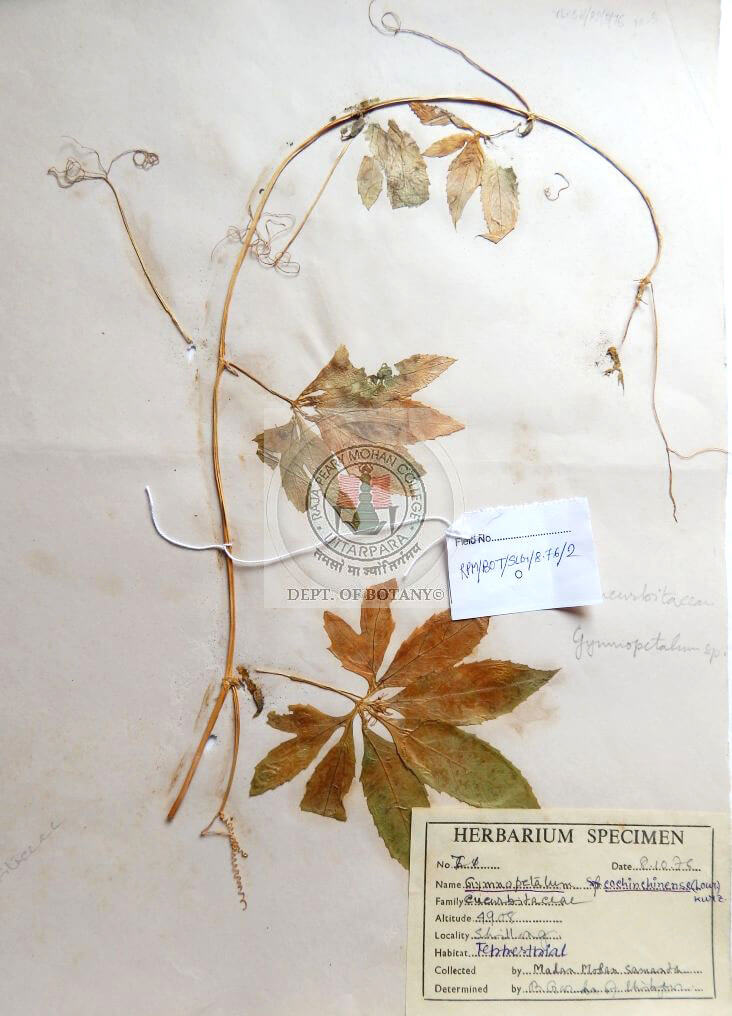
|
| 49 |
Hibiscus vitifolius L. |
Malvaceae |
Perennial herb up to 1•5 m. tall, sometimes scandent or scrambling; stems terete, nearly glabrous or with a very variable indumentum, sometimes tomentose or tomentellous, often glandular, sometimes hispid or stellate-hispid or aculeate and with these different types of hairs occurring in various combinations; leaf-lamina, ovate to suborbicular; not lobed to deeply 3–5 (7)-palmatilobed, with a variable indumentum (as on the stems) but stellate hispid or bifurcate hairs, rather rare on the stems, are more frequent especially on the under surface, margin serrate, base truncate to cordate, strongly nerved; lobes acute or bluntish; petiole hairy; flowers yellow with a dark reddish or purple centre, pendent solitary or forming terminal racemes by reduction of the upper leaves; epicalyx of c. 10 bracts, filiform; calyx long in flower, accrescent, somewhat scarious; broadly elliptic, acuminate, joined to about half-way; corolla regular, yellowish-crimson, Staminal tube up to 15 mm. long; free parts of filaments up to 5 mm. long; style-branches 1•5–3 mm. long, minutely glandular; fruits-Capsule, winged, scarious, usually hispid; valves ± aristate. http://powo.science.kew.org/taxon
|
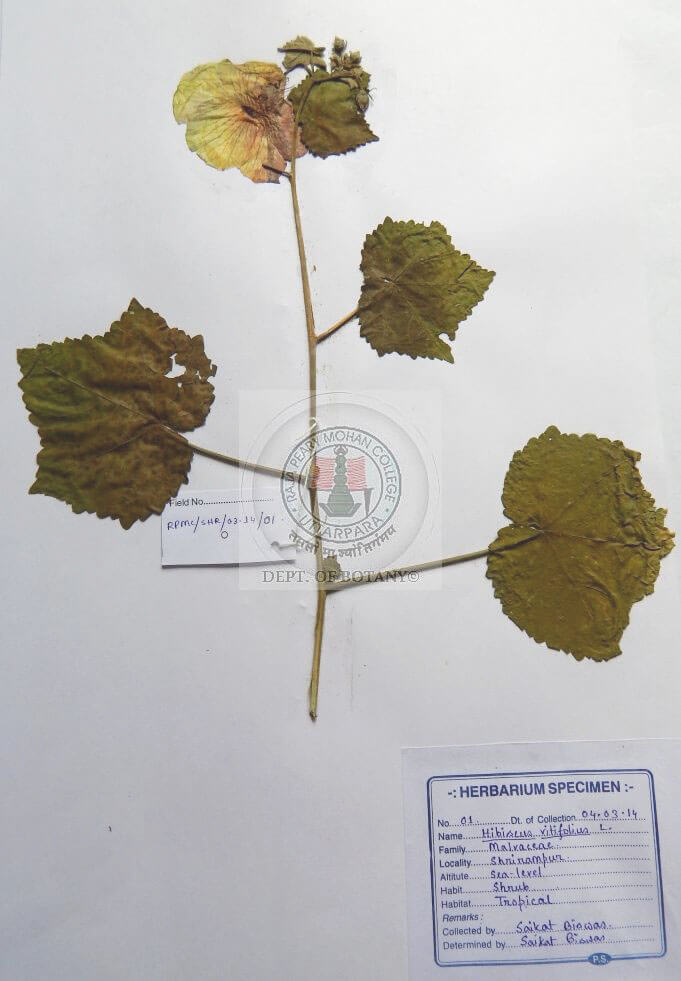
|
| 50 |
Jatropha gossypifolia L. |
Euphorbiaceae |
Perennial upright, deciduous shrub, can grow up to 1-4 m. sparsely branched, sticky, yellow, translucent sap; older stems are thick succulent, younger stems are purple and surface is pubescent; leaves light green, alternate, palmately divided into 3 - 5 lobes, measuring about 4.5 - 10 cm long and 5 - 13 cm wide, purple in young sticky hairy; flowers small, red in terminal corymbose cyme, maroon 5-petaled flowers in terminal panicles, peduncle of each cluster measuring about 10 - 15 cm long, separate male and female flowers in each cluster, male flowers have 8 - 12 yellow stamens while the middle flower of each branch of the cluster is female; tricarpellery; fruits-oval capsule containing three dark brown seeds
|
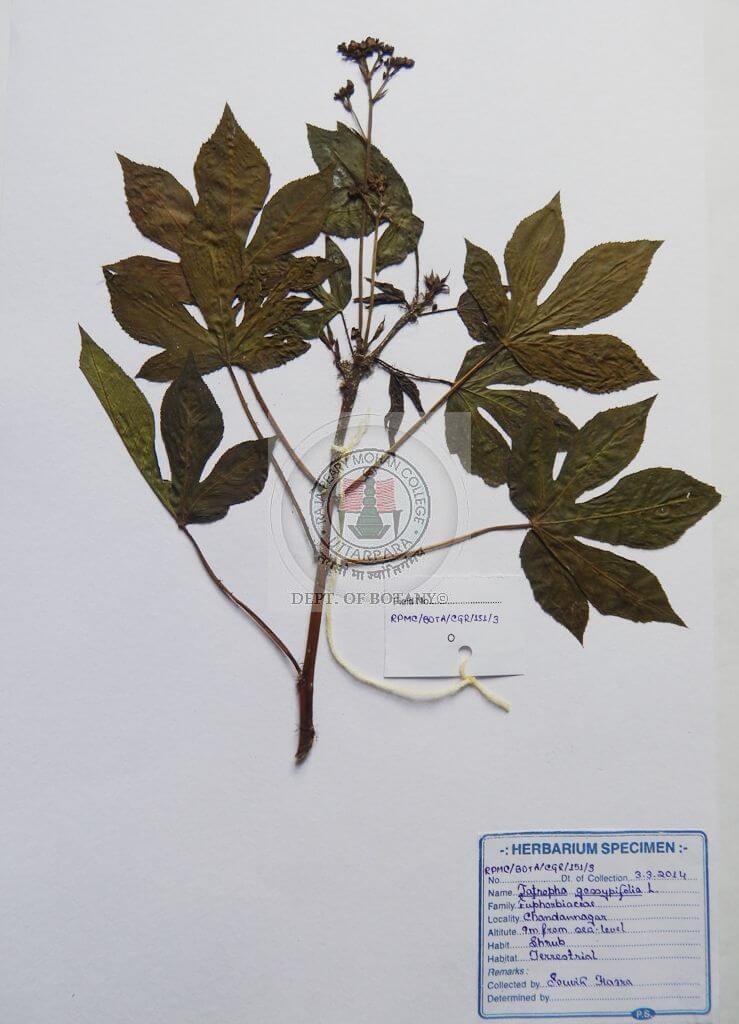
|
| 51 |
Lippia geminata Kunth |
Verbenaceae |
Aromatic, erect, sparsely branched shrub growing up to 2 m; stem branched, hairy; leaves simple, fragrant, decussate-opposite or ternate, deciduous, serrate at margin; inflorescence spicate or capitate, solitary or fascicled in leaf axils; flowers small, sessile, borne singly in the axils of bracts, often more or less 4-ranked; calyx persistent, membranous, gamosepalous, ovoid-campanulate; corolla connate, hypocrateriform or infundibular, 4-lobed, zygomorphic; tube cylindric, straight, slightly exserted from calyx; lobes oblique, spreading, somewhat 2-lipped, the anterior lip larger than the posterior; stamens 4, didynamous, inserted at about the middle of the corolla-tube (epipetalous); anthers ovate, unappendaged, the cells parallel; ovary 2-locular, with 1 ovule/locule in axile placentation; style often short with oblique or sublateral stigma; fruit dry, ovoid, surrounded by the fruiting-calyx and sometimes partially adnate to it, dividing into 2 mericarps or "nutlets" at maturity; pericarp papery or hard; seeds exalbuminous
|
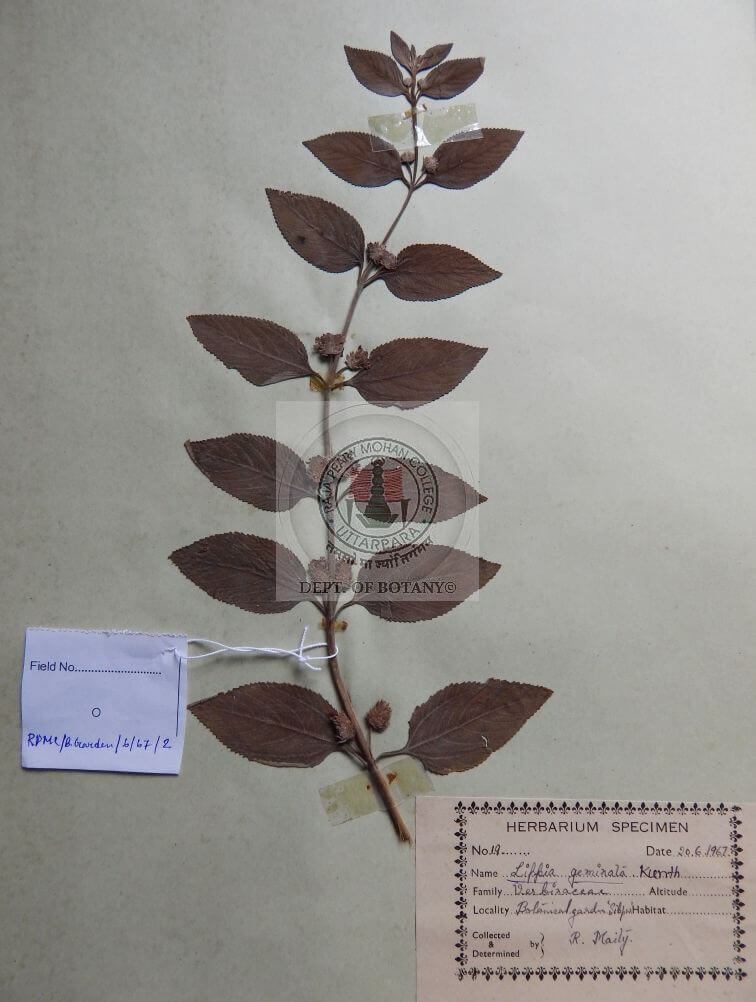
|
| 52 |
Melilotus officinalis (L.) Medik. |
Fabaceae (Leguminosae) |
Annual, erect, 3-8 inch tall, lanky, branched; stems light green, round or slightly terete (i.e. furrowed on all sides), glabrous; leaves compound, alternate, trifoliate, sparsely distributed along the stems; leaflets greyish green, up to 1inch long and 1/3 inch across, dentate along the upper margins, and oblong or oblong-ovate with a pair of small narrow stipules at the base of each trifoliate leafs petiole. The middle leaflet has a conspicuous petiole of its own (i.e. a petiolule), while the lateral leaflets are nearly sessile; flowers white arranged in narrow racemes with a tendency to hang downward from the central stalk of the raceme, and they sometimes appear on only 1 or 2 sides; petals white; flower tubular at the base, becomes broader toward the outer edges of the petals-consist of a standard, a keel, and a 2 lateral aloe or wings; fruit-a pod
|
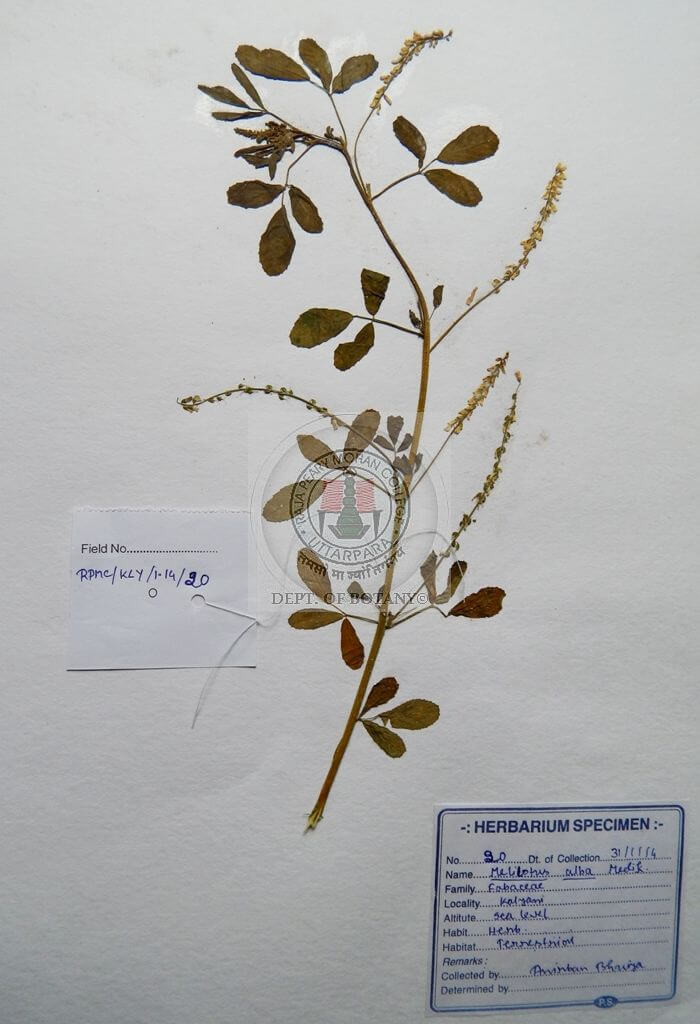
|
| 53 |
Mimosa pudica L. |
Fabaceae (Leguminosae) |
A creeping, annual or perennial, diffuse prickly undershrub; stems cylindrical; sparsely prickly, covered with long, weak bristles longitudinally grooved, external surface light brown, internal surface grey, bark fibrous; leaves digitately compound with one or two pairs of sessile, hairy pinnae, alternate, petiolate, stipulate, linear lanceolate; leaflets 10–20 pairs, sessile, obliquely narrow or linear oblong; obliquely rounded at base, acute, nearly glabrous; yellowish green; flowers pink arranged in globose head, peduncles prickly; calyx very small; corolla pink, lobes 4, ovate oblong; stamens 4, much exerted; ovary sessile; ovules numerous; fruits- lomentum, simple, dry with indehisced segments and persistent sutures having —two to five seeds with yellowish spreading bristle at sutures, glabrous, and straw colored.
|
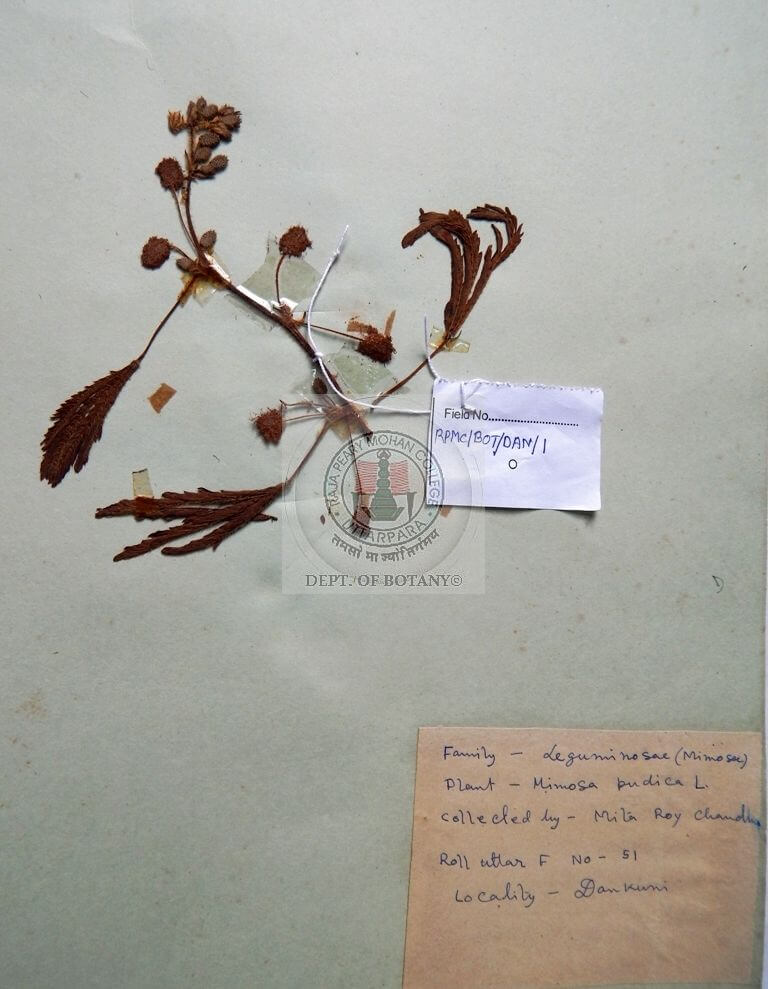
|
| 54 |
Panicum flavidum Retz. |
Poaceae (Gramineae) |
perennial grass, spikes separated by 2-4 times their length, and spikelets (especially in fruit) spherical. Stems (culms) are tufted, slightly compressed. Leaf sheaths are strongly keeled, smooth. Leaves are linear-lanceshaped, flat or folded. Rachis slightly winged, prolonged into a point. Spikelets are plumply ovate, gibbous, milk-white or purplish. Lower glume is broadly ovate; upper glume, 7-veined; lower lemma as long as spikelet, 5-veined; upper lemma bony, granulate.
|
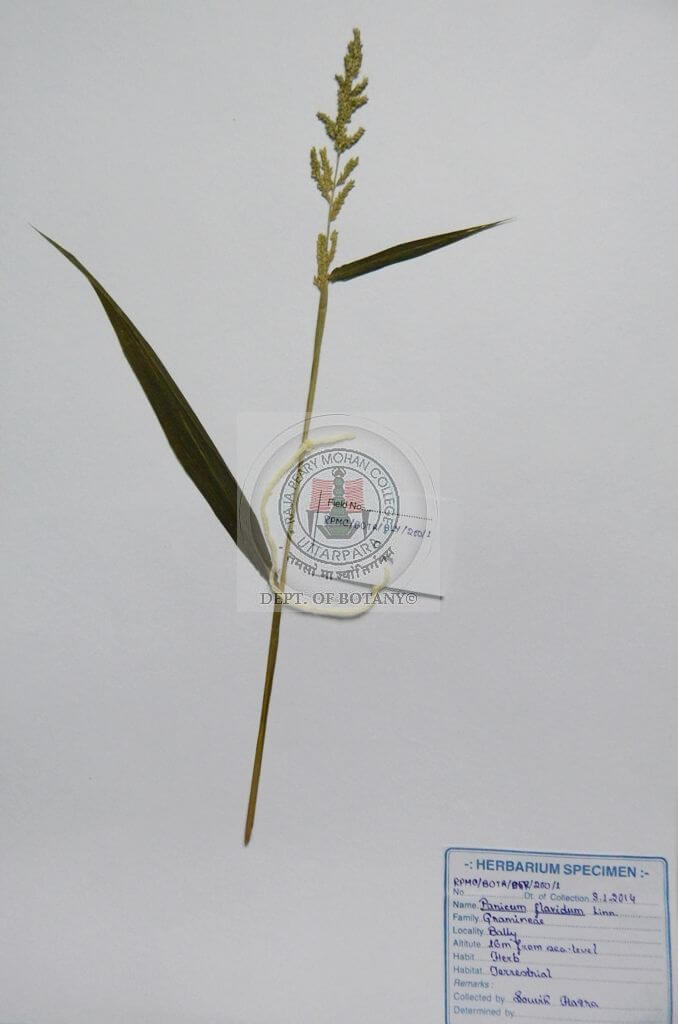
|
| 55 |
Panicum montanum Roxb. |
Poaceae (Gramineae) |
Perennial herb with smooth stem, sparingly branched; leaves thin, glabrous or pilose; Leaf-blade margins scabrous; ciliate; inflorescence a panicle; culms decumbent, or rambling; flowers in spikelet; spikelet sterete, glabrous or faintly hairy, spikelets solitary. Fertile spikelets pedicelled. Second glume fugacious; membranous-ciliate ligules, open panicles with spikelets on long pedicels, the spikelets with upper glume and lower lemma 7–13-nerved, and upper anthecium indurate, with compound papillae at the apex of the upper palea; Anthers 3; 1.6–1.9 mm long. fruits caryopsis with smooth seeds, brown with three strips
|
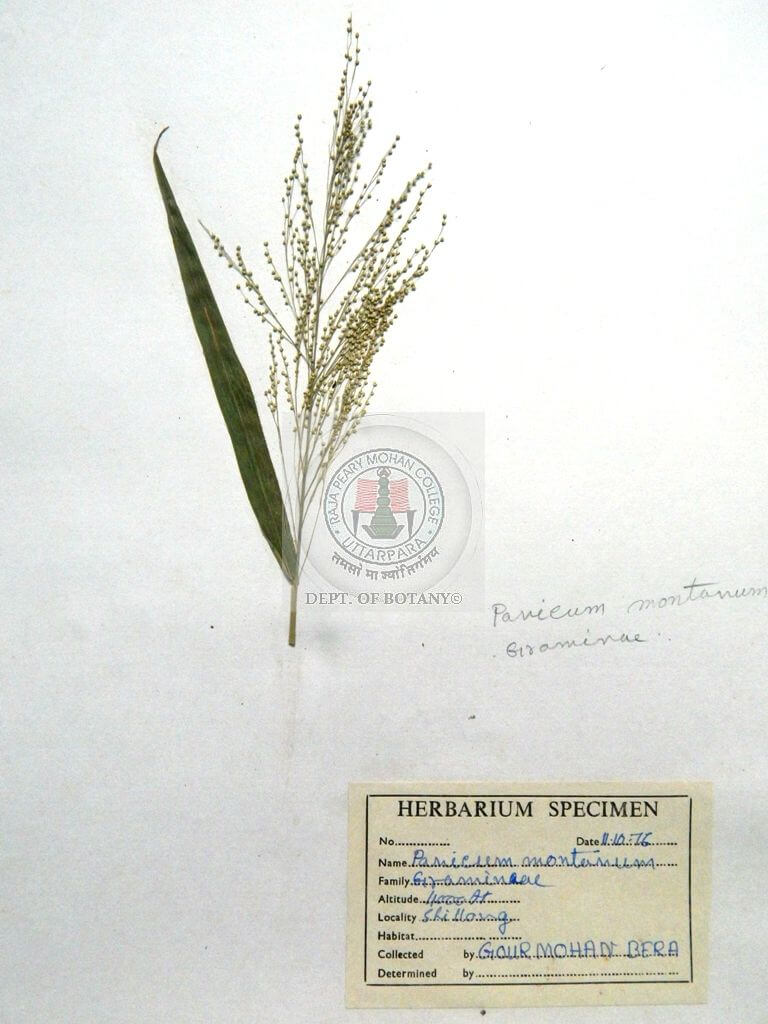
|
| 56 |
Polygonum orientale L. |
Polygonaceae |
Annual erect, herb; leaves slightly hairty, ovate, alternate, stipulate; stipules ochreate; flowers white to pink, arranged in cylindrical raceme, laxly panicled, 8 to 13 centimeters long; perianth of each tiny flower consists of four or five segments, united near its green base and white or pink at the edges. There are six stamens, three fused carpels and three styles. Fruit-a dark brown oval, flattened nut, placentation basal.
|
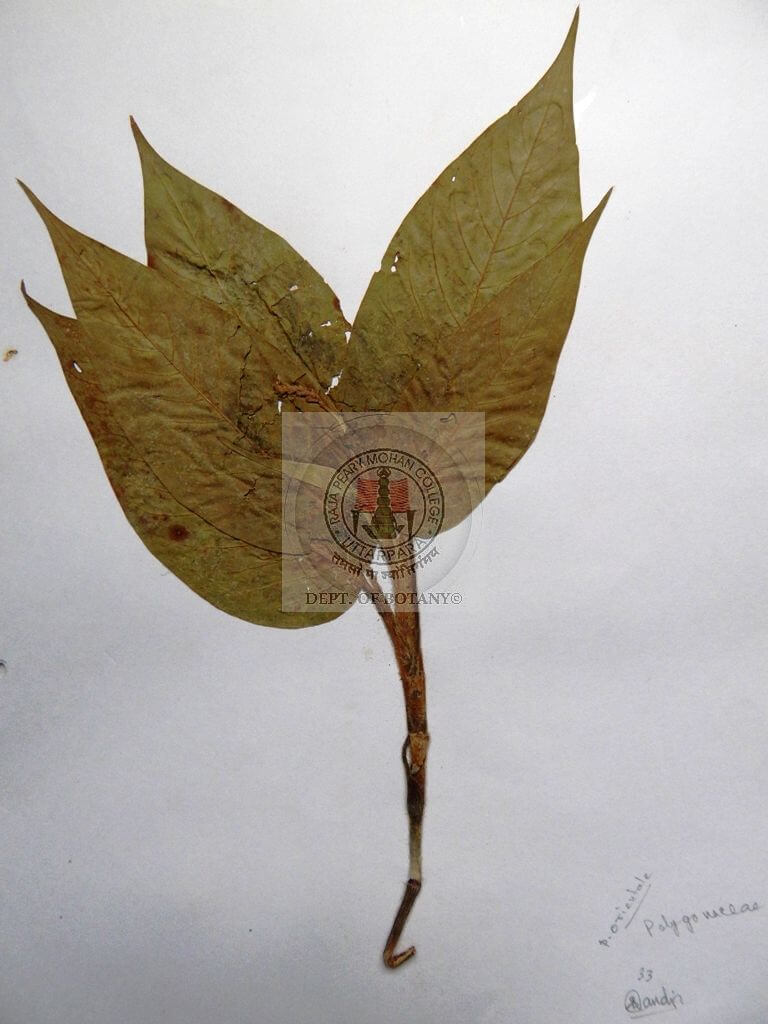
|
| 57 |
Vicia sativa L. |
Fabaceae (Leguminosae) |
An annual scrambling and climbing herb; leaves compound, alternate, stipulate; stipule toothed margins, dark-spotted; leaflets obovate-lanceolate-linear, 1-7 pairs, terminal leaflets modified into a tendril, notched at tip, entire at margins; corolla irregular, purple-red, petals 5 in typical vexillary aestivation, stamens 10-dialdelphous, filaments with fused bases; gynoecium monocarpellary; inflorescence 1-2-flowered raceme; fruits legume
|
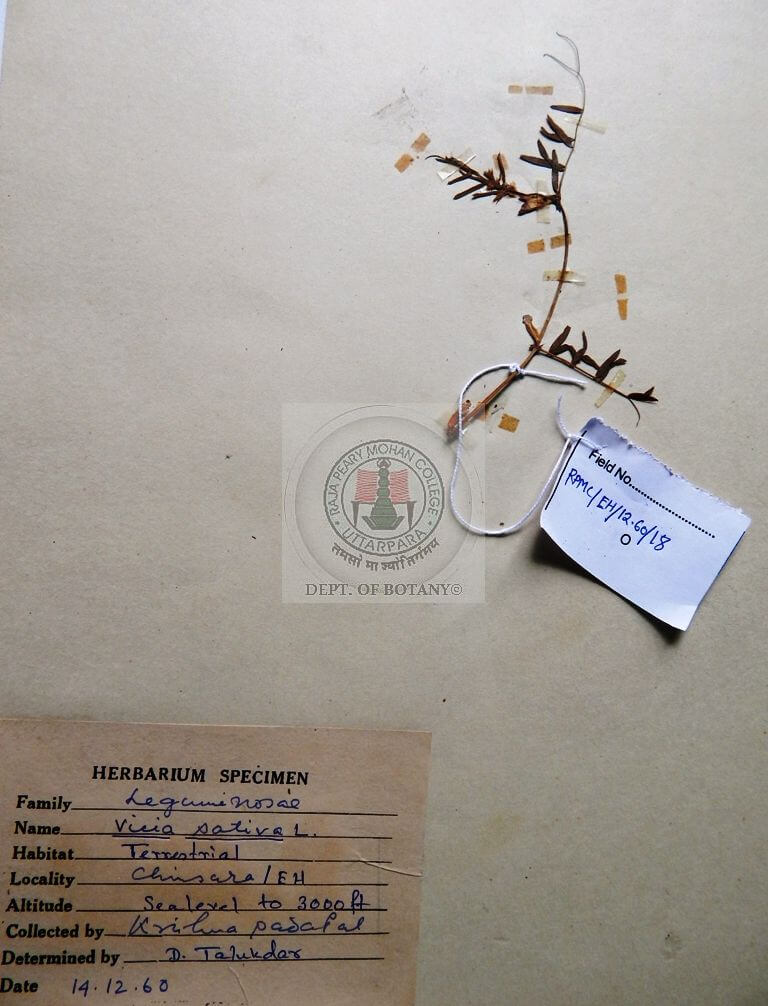
|
| 58 |
Ruellia tuberosa L. |
Acanthaceae |
Herb with tuberous fusiform roots, opposite leaves, winged petioles, stem 4-angled, flowers violet; Cymes dichotomous, few-flowered, bracts narrow; calyx lobes linear, 12-20 mm long, hispid; corolla tube abruptly expanded above, 4-6 cm long, purple, lobes suborbicular; stamens included in throat, strongly didynamous, anthers not overlapping; filaments fused for 1–2 mm at base, free parts 2–3 and 6–7 mm long; anthers 3–4 mm long; capsule linear, glabrous
|
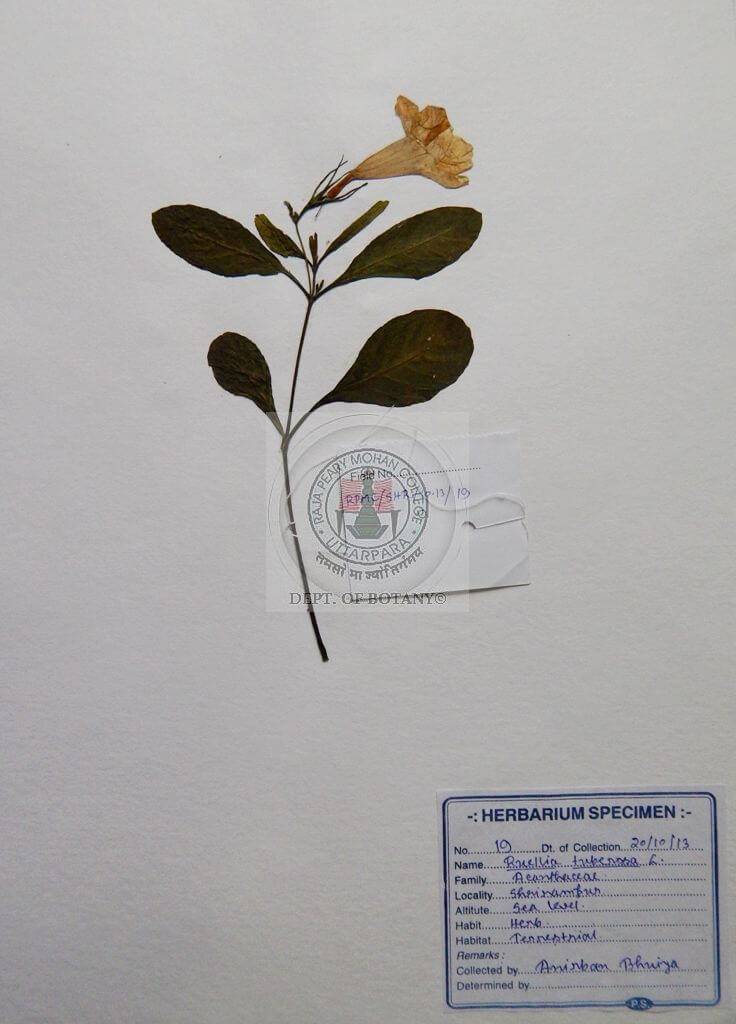
|
| 59 |
Urena lobata L. |
Malvaceae |
A fast-growing, spreading, branched shrub, erect, woody perennial; stems and leaves star-shaped (stellate) hairy; often many branched at the base; leaves simple, alternate, with the upper surface rough and the lower surface grayish, broadly ovate, often with 3-5 shallow, angular lobes at apex, up to 10 cm long; finely toothed at margins, heart shaped at bases; stipulate; flowers small, showy, hibiscus-like, solitary on short stalks in leaf axils, subtended by 5 basally united (involucral) bracts up to 0.7 cm; calyx 5-lobed, hairy; 5 petals, rose or pink, darker at the base, rounded, up to 1.5 cm long; stamens fused into an obvious pink column beneath a 5-lobed style; fruits capsule-small, barbed, spiny
|
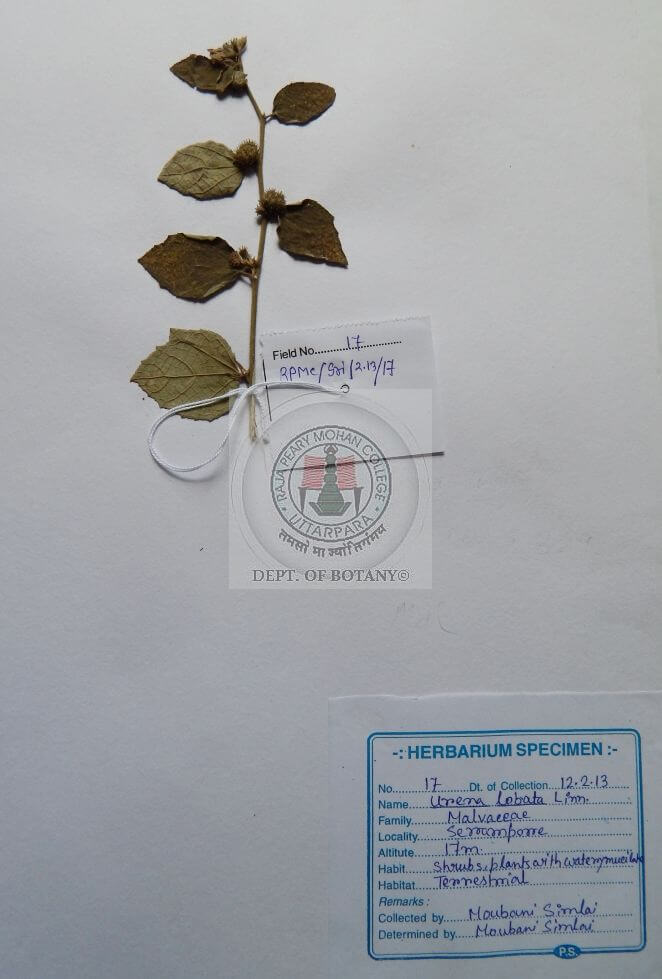
|
| 60 |
Solanum xanthocarpum Schrad. & J.C.Wendl. |
|
A very prickly, bright green, semi perennial, upto 1.5 m grown shrub, highly branched and with bluish-purple flower; stem herbaceous; 8-10 mm thick and variable length with prominent nodes and internodes and prickly nature; green and branches covered with hairs and with prominent furrows (young); when mature glabrous; yellowish green, smooth surface with a thin layer of bark and prominent wood (dry); centre with a large, distinct pith and mature dry stem with hollow pith; leaves exstipulate, petiolate, elliptic or ovate-oblong ,sub-pinnatifid or sinuate, subacute, hairy, green, midrib and veins with sharp prickles; flowers bright blue or bluish purple in colour; ebracteate pedicellate, bisexual, complete, actinomorphic, pentamerous; calyx persistent, gamosepalous, tube globose, short, linear-lanceolate, acute, hairy; corolla gamopetalous, deltoid lobes, acute, hairy, deep purple-blue coloured, stamens 5, epipetalous, basifixed, filament short 1-1.5 mm long; anther, oblong lanceolate; ovary superior, ovoid; bilocular, with many ovules/ chamber in axile placentation, glabrous; fruit globular, berry, with persistent calyx at base, unripe and ripe fruits variegated with green and white strips and yellow and white shades respectively; seeds flat, circular, glabrous.
|
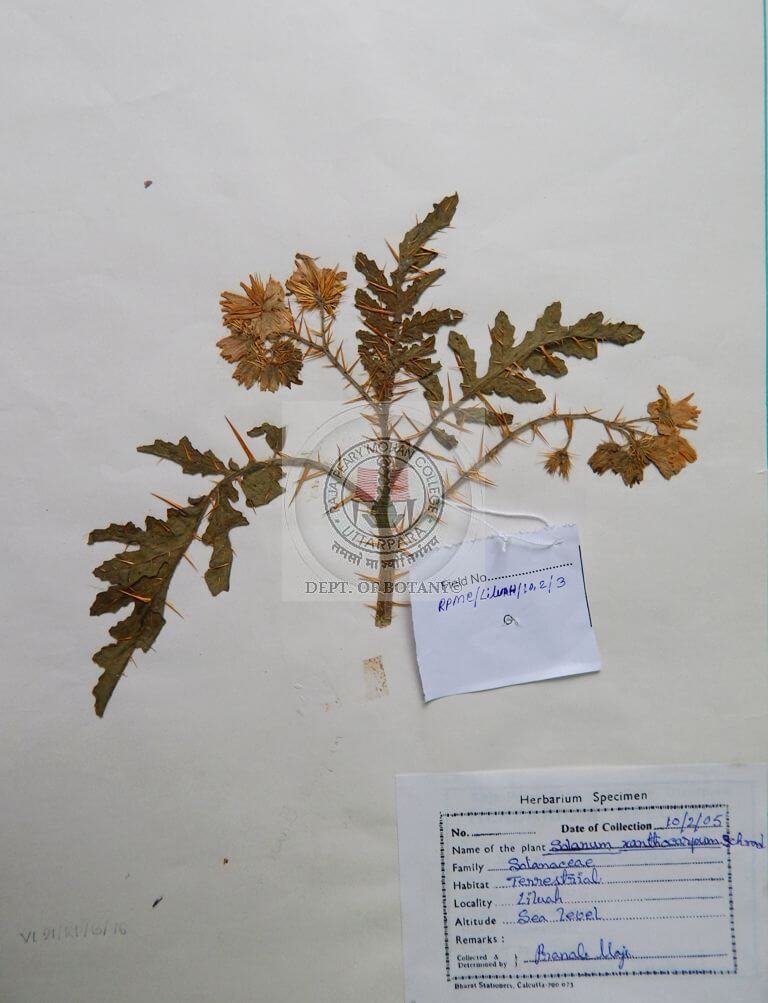
|